#any multi-relationship would have interesting development implications
Note
now im curious as to how disaster!amanda would be in a courtmangelarasha situation. does she pine for the three of them and is genuinely clueless about the reciprocated feelings? is she in a constant state of ‘are they flirting with me or just fucking with me’ ?
HMMM. so the thing about throuple/quartet dynamics is imo, that adding more people to a dynamic is not an addition problem as much as it is like. algebra. yknow. or calculus. w/e. Its not just adding a person, its interplay between all parties involved and their individual and combined dynamics. So while this is probably meant lightheartedly, unfortunately, I ended up thinking extensively about logistics and the how of this, since IMO that changes what Disaster!Amanda looks like and I really want it to feel. Legit. or as legit as RPF gets lmfao.
as always, this is all about RPF amanda, not real amanda, and this is specifically about like, my version of rpf amanda.
in general I think the tricky thing about pining Amanda is that she strikes me as someone to, upon realizing her emotions, either actually have a direct, adult conversation with the person about it, or actively go "oh no". and then do everything in her power to lock that shit down.
So. Hypothetical Amanda might be less of a disaster if she had similar feelings about multiple people simultaneously, over time. I think a key part to my version of disaster!amanda is her being caught off guard, acting in a panic, and then the shitshow that spirals out from that + doubling down. Amanda developing feelings for the three of them over time without confessing to anyone, i think means by the time we hit the full quartet, Amanda would have either tried to do something about communicating, or have somewhat of a handle on how to deal with her feelings solo. (Which could be a great angst thing! But maybe less comedic by that point.)
So in a scenario where Amanda is the only one really out of the loop... hmmm. Tricky for me to immediately come up with the setup. It might need to be something similar to my S&B Courtmangela setup in which the three (Court Arasha Angela) get close and Amanda is like. Fine about it. (Smosh Mouth FOMO tattoo joke style but dialed up x5). And she's flirting with them to deal with it, and they're flirting back, and it just. Keeps escalating. I think there needs to be an element of like, maybe Amanda not realizing she likes them all that way, just knowing she's feeling kind of. Left behind. And she's flirting with them, and they flirt back, and lets be real I think Amanda is the type where if you flirt with her as a bit she Will Double Down, so it would just Keep Going. I think the angst dial is dependent on how much Amanda recognizes her feelings- either she Knows and she's going to hide it from them or die trying (devastating), or she really Doesnt Realize until it culminates in a deeply funny way. Someone is in a kiss with tongue. Shayne is losing his mind because his friend is. A fool. <3
(Angst central: Amanda starts almost exclusively flirting with them when interacting instead of holding proper conversations bc she feels. bad. and is deflecting. Courtney and Angela especially start noticing because hey. They arent clueless. What the fuck. That sucks. Maybe Arasha has to be the one to actually talk to her about it BC Courtmangela have more deeply established ties that are in further jeopardy.............)
OPTIONALLY. if the feelings towards everyone differ drastically/change over time, then it brings back in that fun element of "oh shit oh god oh fuck".
Knowing she would probably try to communicate like an adult, I think there's a lot of fun with the disaster!Amanda in this universe being Amanda not realizing her own additional feelings until comedically late/after other people have already figured it out bc she just doesn't register it as that/is misreading her own emotions/it happens WHILE SHES ALREADY dating one or two of them.
(And again, critically, flirting is happening through all this but not everyone is formally in a relationship.)
My initial instinct about this was "Amangela Courtrasha first", and then the merge. I think a hilarious route for that would be your standard Amangela story, then that all gets sorted. And some time into the relationship, Angela has figured out Amanda's feelings (and her own) towards Courtney and Arasha. + that the flirting that keeps happening is mutual. And so we get:
Angela, loves Amanda (and courtrasha), has slowly realized that Amanda Does Not Realize Her Feelings: 'and you love them too, so-'
Amanda (was staunchly in denial, thought she was safe after figuring out her feelings towards Angela): I WHAT. what. oh shit. THATS what that is???
Or we could have Courtmanda and Arangela first. For max comedy we could have Courtney assuming that Amanda DOES know and so is unbothered by Amanda and Angela acting... well........ wellll...... 👀 and Amanda feels. maybe strange about watching Courtney and Arasha together, not bad but. Strange. (Esp because Amanda has also been looking at Arasha more but maybe she doesnt admit that.) She talks to Court and Courtney compares it to her and Ang and Amanda is okay with them all being- equal, right? (they mean dating but that is lost in the convo). Amanda (clueless) goes. oh like me and ang. of course. :)
And then eventually Angela kisses Amanda and Amanda freaks out and tells Courtney and they're like. .... Amanda did you not know. Amanda tell me you knew. Amanda how did you not realize.
it all works out though. :)
Arasha and Amanda first I'm still thinking about. Maybe a FWB sitch and then... hmm. i might have spent too long on this ask as it is lmfao. ANYWAY. fun ask. sorry if this isnt what you expected.. Unfortunately to me, a 4 person dynamic is not 1 dynamic. its 5-6 dynamics in a trenchcoat.
#my brain gets soo stuck on How the characters get there im so sorry lmfao#i love disaster amanda but i think a criticla thing is that like. for the Disaster™ to hit correctly you have to juxtapose it with like.#the norm. like the disaster behaviour has to have clear and understandable and consistent motivations for it to Hit Right#so for anything prolonged my brain gwts so caught up in like. whats the sunk cost fallacy looney tunes series of events to make this happeb#i AM kind of charmed by the courtmanda one tho... hmmm......#smosh rpf#amanda lehan canto#angela giarratana#courtney miller#arasha lalani#look i DO love amarasha but i think amanda is probably closer/more familiar with court/ang. at least in my universe. so#any multi-relationship would have interesting development implications#when i say i treat rpf as a writing exercise. this is what i mean. sorry.#ask tag#smosh hcs#courtmangelrasha
6 notes
·
View notes
Text
On Words and Meaning
So I've been thinking a lot about how Loki is being discussed and the words used, particularly by Hiddleston, given his bent for using literary language in his descriptions. There are three words I want to touch on in this little post, one of them definitely rooted in his usage.
So the first I want to touch on is the term "romance." We've heard (often from Hiddleston), that Loki is, at heart, a romance. I think there's a dimension of the discussion missing in these conversations in that is important to consider.
To the layman, a romance is simply a love story, sometimes with a sexual undertone. But in the literary sense, a romance is a much deeper genre. I want to consider that this layer may also be present in Hiddleston's intent on using the term in describing the story arc. It certainly is in mine, as someone with a fascination with literary form and also with an English degree who has spent way too much time exploring genre.
So firstly, we need to define "romance." From literaryterms.net:
I. What is Romance?
In the strictest academic terms, a romance is a narrative genre in literature that involves a mysterious, adventurous, or spiritual story line where the focus is on a quest that involves bravery and strong values, not always a love interest. However, modern definitions of romance also include stories that have a relationship issue as the main focus.
II. Examples of Romance
In the academic sense, an example of a romance is a story in which the main character is a hero who must conquer various challenges as part of a quest. Each challenge could be its own story and can be taken out of the overall story without harming the plot.
Example 1
A knight who wishes to prove himself by recovering a stolen heirloom from an enemy may find himself attempting to make his way through a dangerous wood filled with thieves.
Once he has accomplished this challenge, he may find himself climbing a tall mountain on which a group of people are in trouble. He would save the group somehow, and then move on.
Then the final stage: the enemy’s kingdom. There may be a fair maiden whom he meets and somehow helps or rescues, or perhaps she helps him.
But the fair maiden is not the focus of the story – his quest is the focus. Each story can be taken out, yet each builds the hero’s strength to face his final quest. These stories tend to be serious rather than humorous and touch on strong values.
In considering this, I've thought about Loki's arc as a quest that does, indeed, involve the discovery and exploration of strong values with a three part quest, though I don't think the quests entirely stand on their own. The overarching theme is about Loki discovering his sense of self- his quest to become a full person, not just a trope for the universe to exploit so others can reach their better selves. I divide the show up in to three quests. The first, in episodes 1 and 2, is Loki finding a sense of purpose in the new world- his quest is to discover who this new variant is and where they are hiding. This is resolved by the end of that second episode. The second arc takes place in the next two episodes- Loki discovering his empathy for others is the continuation of the overarching personal development plot, while his quest is to discover Sylvie's goals and to uncover/share the truth behind the TVA. And in our third section, episodes 5 and 6, we get the culmination of the personal growth arc in his ultimate discovery of different facets of himself (illuminated by the different elements of self shown in the multitude of variant Lokis) while the quest is to uncover who is in control of the Sacred Timeline and why. The differences in colour palettes, settings, tones, etc. between the three episode pairings is a part of how I started to distinguish my thoughts on each. And regardless of the visual distinctions, I most definitely see the entire arc as exploring strong values and bravery, though the bravery is multi-layered, showing not only the visible bravery of facing down an apocalypse, Alioth, etc., but the internal bravery of challenging one's self and digging deep into discovering who one really is. This is a theme of queerness that I see lingering in this series- discovering who we are is a process, not an outcome.
I think that this definition of a romance, in the classical sense, is a little oversimplified, as there is often a theme of discovery of self or improvement of self along the way. In a Gothic romance, themes of "the people are the real monsters" come into play (Crimson Peak is an excellent example of this)- there may be elements of the supernatural, but the real thing of which the viewer/reader should be afraid is the person behind the curtain. Gothic romances also often do include a love story arc, but it is often deeply flawed on some level and often also includes some sort of sexual or romantic awakening, often by a female lead, that leads to the discovery of whatever darker is taking place (Crimson Peak turns this on its head in that it is Thomas' awakening with Edith that leads to his turning point and Edith's realization that the Sharpe siblings are the monsters, not the ghosts in the hall). The themes of discovery of self, or of the fortitude of moral values, or of the journey of a person's development, play into both a Gothic romance and its foundations in a classical romance.
So. There's part 1 of this ramble.
On to part 2!
The next word I want to examine is the term "relationship" and its companion, "love." Now, mind you, I come at this from a queer perspective as a demisexual, demiromantic individual, so these two words are ones I've spent a LOT of time pondering, in the quest to define my own identity.
We've heard the term "relationship" tossed around so often with only a romantic implication attached, but in truth, this word is so much more broad than this. You are in a relationship with your barber. You are in a relationship with your cat. You are in a relationship with a spiritual advisor, a professor, your best friend, your partner. Just because it is so heavily used in this way doesn't mean the relationship is only an intimate one (though intimate relationships are also not inherently sexual or romantic in nature, either, so let's remember this as well). Now if we break down what a relationship is, it's just a consistent interaction with someone based on some common interest or goal. It's a remarkably benign word. Its connotations, however, take it in a multitude of directions.
So let's look at it through the lens of an intimate relationship and add in the component of love. We'll start with just a blanket statement that love is not only one single thing. It isn't just romantic. It is our family, our friends, our pets, pie, the colour blue, that feeling of perfection when the waves of a warm lake brush over your calves...love is embedded in the experiences of these things. We love them. Love it as vast and broad as relationships. We love places, people, things, and experiences. We love ourselves (or we try to learn to).
In my world, through my particular brand of queerness, love changes in intimate relationships on a regular basis. I love my partner dearly. But on some days, that love is to my best friend, while other days, it is a romantic love and on others, sexual expression may be involved, but they may overlap in different ways. Sexual expression is independent of romantic attraction and the degree of each isn't tied together in any way. If we can separate these things, I think we can see the relationships in our everyday lives in different lights and with greater complexity.
I also think that looking at these things through the lens of diverse sexual and romantic experiences can inform how we interpret the Loki x Sylvie pairing and why some of us just aren't bothered by it (though certainly not the only reason people aren't).
We've been told Loki loves Sylvie. That much is beautifully clear. But love (and being in a relationship) doesn't automatically mean that 1) both parties are experiencing it in the same way, 2) both parties have the same approach or priorities, 3) the level of romance is necessarily the same between the people involved, 4) that sexual attraction exists at all.
Sometimes a kiss is a form of communication and not tied to the want to shag someone.
So this is where my interpretation of this particular pairing comes into play. I do see the story as a romance, in the classical sense, but also with a slight streak of the more modern sense involved. The focus is still on the quest, even when the love story emerges. And that is where I see the priorities of these characters and their definitions of the relationship differing and I analyze it through these different dimensions of love and relationship orientations.
Loki actually embodies one of the traits I've seen listed for demisexuals- we hold our friendships extremely close and because we hold our friendships the way we do, it isn't uncommon for us to end up with crushes on our best friends (and no, they don't generally develop into other forms of relationships, but they could). This is the phase in which I see Loki by episode 6. He has formed this intense bond, unlike any other it seems he's had, and his heart is breaking over the thought of losing her to her own rage. All he wants is for her to be OK, remember? This isn't a selfish action. But I think it is significant that while he tries to stop her, he's not the one who initiates the kiss. All his actions here are ones that a close friend would also do for their best friend. Like, I'd try to stop my besties from inadvertently destroying the universe. I'd even throw down over it. And for the exact same reasons- the risks are too great, we need to think, and I want them to be OK. Almost everything Loki does throughout his growing closeness to Sylvie is something I'd do for one of the people I've told I'd defend- as in, I literally told some of these people, "anybody messes with you, I'll cut a bitch- just tell me who and I'm there."
So because of all this, I don't see this relationship as sexual in any way. Romantic? Possibly. But not necessarily. Even being in love with one another doesn't mean a relationship has to have a sexual component.
Looking at Sylvie, I see her also as having found companionship with Loki, but her overriding goal is, ultimately, not to bond with someone- it's her mission. And she has sacrificed her entire life because of the TVA to this mission. She tells him repeatedly, in one way or another, that the mission comes first. Yes, she does care about him, but I don't think the way she cares about him is the same as the way he cares about her because they have differing priorities and needs (and hence why she feels betrayed by him when he tries to stop her). Or at least she hasn't allowed herself to express that. When she falls to the ground after she's killed He Who Remains, I think we get a glimpse of what Loki meant to her- she is alone, she grieves, and there is no meaning left to her story. She's done what she dedicated her entire life to and the person who could have given it other meaning is no longer beside her.
I still don't think that the first thing they would do upon seeing each other is suck face and have wild sex. Would that bother me? No, not really. I can headcanon something different than what actually happens, I'm fine with that (just look at all this glorious headcanoning happening right here!) I'd like it to stay a romantic friendship (queer platonic relationships for the win- they're squishes!) because I don't think we hardly ever see those types of relationships and queer platonic relationships are incredibly beautiful and powerful and yes, based on love and maybe even romance, in their own way. They are defined by the people in them, as are all relationships.
And now to address "but she kissed him!"
Yes, she did. And I've kissed my partner when there wasn't romance involved because I wanted to share a moment, to express something deeper than I had words for (yes, even on one of my aromantic leaning days), or just because it's fun. And it doesn't have to "match" up with how the other partner feels it, either, so long as the message itself is what comes across. This is how I read the Sylvie x Loki kiss. It was a message of worthiness. Loki's entire arc, including in that scene, is in discovering if he's anyone different than the monster he's made himself out to be (and encouraged others to see him as). He tells Sylvie that he can't be trusted, falling back on the habit of characterizing himself as the professional liar, the one who can't form those attachments which are built on trust. He also identifies her as someone incapable of trust in that moment, which I think is also a projection of how he sees himself. He tells Mobius he can only trust himself and the show slowly shows Loki coming to trust others, but in this moment in the Citadel, he's falling back on a different perception of himself.
This is where the kiss comes in, for me. Sylvie isn't trying to tell him she'd jump him right then and there, if things were different. Sylvie is trying to tell him that she does trust him, that he can be trusted, and that he is worthy of the affection of a friend, even if she can't have him in her way. She is prioritizing her mission, yes, but not without giving him some sort of reassurance, in her own way, that this rejection isn't personal. That he isn't too broken to be loved. It doesn't have to go into romance (not saying it couldn't, just saying it isn't a requirement). It doesn't have to go into sexual relationship territory.
Maybe I see this so vastly differently because of my experiences exploring gender, sexuality, and romantic orientation. Maybe I see this so differently because at this stage in my life, I would absolutely kiss a friend if I felt something so heavy was going to break them. I have a friend I say "I love you" to every time we talk on the phone or video chat- we've been together for 20 years. I've got photo proof of a snuggle pile of friends when I was a young adult. I've shared a bed with a friend with no reason other than that we didn't want to sleep on the floor and why not. I've had friendships that were awkward to start and intense once they got going that are absolutely still important in my life. I've had crushes on friends that have faded and just shown me another dimension of what it is to love someone. I've watched adults who struggle to make connections to other people discover those moments of awkward "how do I do friend mode?" and come out stronger for them, with that huge sense of victory hidden behind a small smile they don't want to share with anyone else quite yet.
I see so much possibility in how we interpret a television show reduced to "it's a romance and that's sick and incest and he wants to fuck himself!" and it just saddens me that so many people have such a limited understanding and experience of the depth and breadth of human relationships and of how people love one another.
18 notes
·
View notes
Text
Miranda Otto’s Filmography as seen through a specific lens
otherwise known as: I watched some of these things so you don’t have to. But more specifically, I want to share basic information about which of her films and tv series require trigger warnings. Honestly, I’ve never recovered from some of them (thinking about In Her Skin... but also Homeland... because what the actual fuck, Saul?)
This isn’t a complete list. It’s only 21 of over 60 credits Miranda has to her name, but I think these are probably some of her most famous roles. Please let me know what you think of these brief descriptions, and whether anything should be added or removed.
It should go without saying that there are spoilers below. Read at your own risk.
Chilling Adventures of Sabrina: Zelda Spellman
A powerful role, but be aware Zelda is abused, raped (implied), and violently murdered (twice)
Downhill: Charlotte
I love this woman with all my heart, okay? Miranda Otto is supposed to be playing the most heterosexual woman ever, and instead manages to make every single scene gay as fuck.
The Silence: Kelly Andrews
Gets her leg mutilated (also it’s implied that she and Kiernan’s character would be made sex slaves by this random cult that shows up... which is super tasteful and not at all disgusting)
Annabelle: Creation: Esther Mullins
Face mutilated, eventually murdered (I think? It’s been a long time since I’ve seen this one)
24: Legacy: Rebecca Ingram
Powerful woman kidnapped, tortured, and violently murdered
Homeland: Allison Carr
Powerful woman violently attacked by her former lover in full view of her coworkers. Riddled with bullets while she is curled in a trunk.
The Daughter: Charlotte
I’ve made a whole post about how I think Charlotte was raped by her employer, and that it therefore shouldn’t be framed as a sexy affair… but here we are.
I, Frankenstein: Leonore
Powerful woman kidnapped and used as a bargaining chip. I’ve also made a post about this one, and how Miranda Otto claims this part could have been played by a man, but the blatant sexism around the kidnap and ransom—making a woman who is the leader of warriors powerless to fight back against her attackers, and having her rescued in a way that frames her as a damsel in distress (complete with bridal carry)—makes me believe that Miss Otto doesn’t notice just how much sexism was written into the role.
Reaching for the Moon: Elizabeth Bishop
While as a whole, this movie is beautiful and wonderful and one of my all-time favorites, we need to still acknowledge that Lota and Elizabeth were in an incredibly toxic relationship—which I actually think is great representation, because abuse doesn’t just happen between a husband and a wife, or a boyfriend and a girlfriend, it can happen to anyone with any partner.
Miss Fisher's Murder Mysteries: Lydia Andrews
I unapologetically adore Miranda in this one. She is so convincing as the grieving widow that the plot twist caught me completely by surprise. This is perhaps the only role that I’ve seen Miranda play where a bad woman was brought to justice, but in a way that had absolutely nothing to do with her gender. Justice was neutral and exacted without prejudice, in this case.
In Her Skin: Mrs. Barber
This is one of the most upsetting and disturbing films I’ve ever seen. Miranda Otto is brilliant in it, but playing the role of a mother whose daughter went missing (and then was brutally murdered) definitely took its toll. I will never understand why the movie released an interview during which Miranda was clearly distraught. She breaks down into tears multiple times just trying to talk about this movie (which was a real-life murder case).
Cashmere Mafia (TV Series): Juliet Draper
Okay, I LOVE LOVE LOVE Juliet Draper. I would cherish her and dote on her for the rest of her life if she were my wife. But in the actual show, her husband is a serial cheater. When her friends find out about it, they don’t judge her broken marriage, but they do give her the courage she needs to leave him. They tell her she deserves more—and she does!! But in the final episode there is a pretty disturbing plot about a multi-millionaire who wants to buy not only her Hotel company but also her… which is exactly as bad as it sounds.
War of the Worlds: Mary Ann
Miranda Otto is heavily pregnant and glowing in a grand total of five minutes of this movie, but oh, what wonderful five minutes!!
The Lord of the Rings: Eowyn
This is the role for which Miranda is most famous. I have nothing bad to say about Eowyn, except that she ought to have been given more screen time, and that there shouldn’t have been that creepy plot about the King’s advisor or whoever wanting to have sex with her. It was incredibly unnecessary and frames Eowyn as a potential victim in the beginning, which was completely unnecessary in terms of character/plot development.
Danny Deckchair: Glenda Lake
Glenda Lake is a precious cinnamon roll, too good for this world, too pure. Please for the love of Otto watch this film for baby Miranda in a sweet romantic comedy.
Julie Walking Home: Julie Makowsky
I don’t understand this film at all. It has one of the most absurd plots I’ve ever seen. Miranda’s husband/partner cheats on her and gets caught, and then he gets violent (in front of her children and multiple adult witnesses!!), and then their son gets cancer, and then she goes to Poland, and then a Healer tries to cure her son, and it works for a while, and eventually Julie (Miranda) has sex with the Healer, in order to teach him how to have sex? and then she gets pregnant by this man, and then her son’s cancer comes back, and then the Healer runs for the hills, and then her former partner takes her back so that they can all be a family again....?!?!?!?!
Human Nature: Gabrielle
This film made Miranda popular with a lot of creepy old men (okay maybe just Bruno Barreto based on this interview… (seriously I am so uncomfortable with the way he’s like… oh yes, I knew her from that film... and then later *places his hand on her bare knee/thigh* Lowell doesn’t give a shit about (Elizabeth/Miranda) being awkward!
(the implication being that Lowell is only interested in getting Elizabeth into his bed...)
anyway… she plays a sexy French scientist, who isn’t actually French. There’s lots of lingerie, dancing, and kissing.
The Jack Bull (TV Movie) Cora Redding
Miranda Otto dies an incredibly violent death in period costume for no apparent reason besides generating male pain.
Dead Letter Office: Alice Walsh
Young!Miranda is so cute in this, but there’s a sort of ambiguously creepy older man-younger woman relationship… because Alice (Miranda) is looking for a father figure… and anyway I don’t remember this film well enough to comment more specifically, but I remember it being lovely except for the age difference between Alice and the guy in charge of the missing letters.
Doing Time for Patsy Cline: Patsy
I watched this purely for Miranda, and I do think it’s good, but only her part in it. Miranda plays the “busty bimbo with a heart” incredibly well. I remember being scared for her character, because her husband was a mean drunk/drug addict, but I don’t think any actual violence gets portrayed… but someone who has watched this more recently can correct me if I’m wrong.
Sex is a Four Letter Word
I only made it through half of this film before I turned it off. I wouldn’t watch it unless you’ve ingested/inhaled some substances and don’t mind people monologuing about their terrible sex experiences.
...
Let me know if you’d like to know more about any of these films!
99 notes
·
View notes
Text
Ian’s Case: A Personal Statement for Grad School Admission
Personal Statement, Ian Deleón
“He felt something strike his chest, and that his body was being thrown swiftly through the air, on and on, immeasurably far and fast, while his limbs were gently relaxed.”
It was more than a decade ago when I first read those words. Written by the American author Willa Cather, Paul’s Case: A Study in Temperament has always felt to me like an intimate account of my own life penned by a woman one hundred years in the past.
That is a feeling which makes me proud; that my personal whims, fears, and desires, could find their echo long ago in a story about a young man and his pursuit of a meaningful life. Because of it, I felt a pleasing sense of historicity at a time when I was struggling so much with my own.
I grew up in Miami Beach. Literally not more than a block away from water for most of my life. My father had emigrated from Cuba with his family in 1980. My mother had come on a work visa from Brazil a few years later. They met on the beach, had an affair, and I came into the world in May of 1987.
My life was marked with in betweenness from the very beginning. My parents’ relationship did not last long, so I grew up traveling between houses. I had two families. I was American, but I was also Cuban and Brazilian. I even have a Brazilian passport. I spoke three languages fluently, but I couldn’t dance salsa or samba. I felt at home with the working class immigrants and people of color in my neighborhoods, but I often had to work hard to prove I wasn’t just some gringo with a knack for foreign tongues.
[A quick note on Paul’s Case––If it happens that the reader is not familiar with the short story, let me briefly summarize it here: A disenchanted youth in turn of the century Pittsburgh feels increasingly alienated from his schoolmates, his teachers and his family. His only comfort is his position as an usher at Carnegie Hall, where he loses himself in the glamour of the art life. Having no drive or desire to become an artist, however, the dandy Paul makes a spur of the moment criminal decision and elopes to New York City. There, he is able to live out his fantasies in a financial masquerade for about a week’s time, until the authorities back home finger him for monetary theft. Learning that his father is en route to the city to collect him, Paul travels to the countryside and flings himself in front of a speeding train, musing about the elegant brevity of winter flowers.]
When I first encountered Cather’s short story I was blown away by the parallels I saw between my own life and Paul’s. In 2005, fresh out of high school, I was living mostly with my father as my mother had relocated to faraway West Palm Beach. I was an usher at the local concert hall, a job I cherished enough to volunteer my time for free. I became entranced by the world of classical music, opera, theater, and spectacle––often showing up for work early and roaming the performance spaces, probing high and low like some kind of millenial phantom.
In school, however, I had no direction, no plan. I had good enough grades, but no real motivation, and worst of all, I thought, no discernible talent. I probably resented my father for not being cultured enough to teach me about music, theater, and the arts. No one in my family had ever even been to a museum, or sat before a chamber orchestra. And it didn’t seem to matter to them either, they could somehow live blissfully without it.
Well I couldn’t. I began to mimic the fervor with which Paul immersed himself in that world, while also exhibiting the same panic at the thought of not being able to sustain my treasured experiences without a marketable contribution to them. But here is where Paul and I take divergent paths.
I was attending the Miami Dade Honors College, breezing my way towards an associate’s degree. I took classes in Oceanography, Sociology, Creative Writing, Acting and African Drumming. I was experimenting and falling in love with everything.
But it was my Creative Writing professor, Michael Hettich, who really encouraged the development of my nascent writing talent. Up until that point my ideas only found their expression through class assignments, particularly book reports and essays on historical events. My sister had always felt I had a way with words, but I just attributed this to growing up in a multicultural environment amongst a diversity of native languages.
As a result of that encouragement I began to write poetry, little songs and treatments for film ideas based on the short stories we were talking about in class. Somehow, thanks to those lines of poetry and a few amateur photographic self portraits, I was admitted to the Massachusetts College of Art & Design for my BFA program.
There, I attended classes in Printmaking, Paper Making, Performance Art, Video Editing, and Glass Blowing. I was immersed in culture, attending lectures and workshops, adding new words to my vocabulary: “New Media” and “gestalt”. I saw my first snowfall. I had the dubious honor of appearing at once not Hispanic and yet different enough. I was overwhelmed. I felt increasingly disenchanted and out of place in New England, yet my work flourished and grew stronger.
It was during this time that I developed a passion for live performance and engagement with an audience. I also worked with multi-channel video and sculptural installations. Always, I commented on my family history, grappling with it, the emigrations and immigrations. I even returned to those early short stories from Miami Dade, one time doing an interpretive movement piece based on The Yellow Wallpaper. Most often I talked about my father. He was even in a few of my projects. He was a good sport, though we still had the occasional heated political disagreement. We never held any grudges, and made up again rather quickly. It would always be that way, intense periods of warming and cooling. A tropical temperament, I suppose.
I continued to take film-related classes in Boston, but my interests gradually became highly abstracted, subtle, and decidedly avant-garde. I had no desire to work in a coherently narrative medium. This would eventually change, but for now, I let my ambitions and aspirations take me where they would.
I returned home to Miami for a spell after graduation. I traveled the world for five months after that. I moved back to Boston for another couple of years, because it was comfortable I suppose, though I was fed up with the weather.
Finally, I wound up in NYC. Classic story: I followed a charming young woman, another performance artist as luck would have it, a writer too, and a bit of an outsider. We were quickly engaged and on the first anniversary of our meet cute we were married on a gorgeous piece of land in upstate new york, owned by an older performance-loving couple from the city. Piece of land doesn’t quite do it justice, we’re talking massive tracts, hidden acres of forest, sudden lakes, fertile fields, and precocious wildlife. As they say in the movies, it really is all about location, location, location.
Nearly all of our significant personal and professional achievements in the subsequent years have centered around this bucolic homestead. After meeting, courting, researching and eventually getting married there, we soon decided we would stage our most ambitious project to date in this magical space––we would shoot...a movie.
We hit upon the curious story of an eighteenth century woman in England called Mary Toft. Dear Mary became famous for a months-long ruse that involved her supposed birthing of rabbits, and sometimes cats. The small town hoax ballooned into a national controversy when it was eventually exposed by some of the king’s physicians. My wife and I were completely enthralled by this story and its contemporary implications. Was Mary wholly complicit in the mischievous acts, or was she herself a sort of duped victim...of systematic abuse at the hands of her family, her husband, her country?
We soon found a way to adapt and give this tale a modern twist that recast Mary as a woman of color alone in the woods navigating a host of creepy men, a miscarriage, and a supernatural rabbit.
Over the course of nine months, our idea gestated and began taking the form of a short film screenplay. This was something neither of us had done or been adequately trained to do before. But we knew we wanted it to be special, it was our passion project. We knew we didn’t want it to look amateurish––we were too old for that. So we took out a loan, hired an amazing camera crew, and in three consecutive days in the summer of 2017 we filmed our story, Velvet Cry. It was the most difficult thing either of us had undertaken...including planning our nuptial ceremony around our difficult families.
It was an incredible experience––intoxicating––also quite maddening and stressful. But it was all worth it. Because of our work schedules, it took us another year to finish post production on the film, but throughout that process, I knew I had found my calling. I would be a writer, and I would be a Director.
Perhaps I had been too afraid to dream the big dream before. Perhaps I had lacked the confidence, or simply, the life experience to tackle the complexity of human emotions, narratives, and interactions––but no longer. This is what I wanted to do and I had to find a way to get better at doing it.
In the intervening months, I have set myself on a course to develop my writing abilities as quickly as I could in anticipation of this application process. I know I have some latent talent, but it has been a long time since I’ve been in an academic setting, and in any case, I have never really attempted to craft drama on this scale before.
I’ve read many books, listened to countless interviews, attended online classes, and most importantly, written my heart out since relocating down the coast to the small college town of Gainesville in Central Florida with my wife in June of 2018. It was through a trip to her alma mater of Hollins University that we learned about the co-ed graduate program in screenwriting a few months ago. After all the debt I accrued in New England, I didn’t think I would ever go back to college, though I greatly enjoyed the experience. But what we learned about the program filled me with confidence and a desire to share in the wonderful legacy of this school that my wife is always gushing about.
Our Skype conversation with Tim Albaugh proved to be the deciding factor. I knew instantly that I wanted to be a part of anything that he was involved with, and I had the feeling that my ideas would truly be nurtured and harnessed into a craft––something tangible I could be proud of and use to propel my career.
I continue to mine my childhood and adolescence in Miami for critical stories and characters, situations that shed light on my own personal experience of life. I’ve found myself coming back to Paul’s Case. No longer caught up in the character’s stagnant, brooding longings for a grander life, I’m now able to revisit the story, appreciating the young man’s anxieties while evaluating how it all went so fatally wrong for Paul. There was no reason to despair, no cause for lost hope. I would take the necessary steps to become the artist I already know myself to be. The screenplay I am submitting as my writing sample is a new adaptation of this story, making Paul my own, and giving him a little bit of that South Florida flavor.
I will close by reiterating how I have visited Hollins, and heard many a positive review from the powerful women I know who have attended college there. As a graduate student, I know Hollins can help me to become a screenwriter, to become a filmmaker. This is the only graduate program to which I am applying––I have a very good feeling about all this.
I want to be a Hollins girl.
2 notes
·
View notes
Text
things a new rp partner should know about me !
fun new meme here ! write 3-5 things a new rp partner ( or those who want to be ) should know about you and tag 3-5 people! it should be related to rp and not to other interests.
tagged by: the ever so kindly @patricursed !
tagging: too lazy to tag this time. just take it and tag me if you did!
( previously answered here! but i’ll engage this one differently. )

I. you as a mun come first to me and then your ic content (basically ‘friend before rp partner’). I know we’re all here as writers and to have fun from that writing, but I see this place as a means to get to know people and make friends. Outside of rping, let’s make jokes, talk about our shared interest in series (even if we’re rping in it or not), or about anything, really. It is as important to have a backbone of a relationship that extends a bit outside of ‘oh hey we’re writing, sending plots and anons, etc.’
II. com~mu~ni~ca~tion is key! I like hearing people, I like making jokes and puns. My personality is considered laid-back with some carefulness to it -- if not, throwing it into the wind if we vibe enough. If you have problems, see something I’m doing is not so great (or I’m interacting with someone who has some serious allegations, etc), just notify me. Don’t trouble me with anons and stuff, just come to my DMs!
III. i’m an easy shipper and plotter if we talk a lot, i’m also a sadist. Honestly, just ask people who I ship (romo, plato) with-- if a particular meme is written and we’re already comfortable and stuff, I can easily get on board with romances, enemies, friendships. The friendship part is super easy to do with my character’s personality -- but the possibilities and plots open up if we can bounce off of another. I admit I do not always vibe with certain plots or relationship ideas because it takes me more to get comfortable with (ie: relatives/family, I do that with close rp partners or I actually see it plausible too nfdskjfs).
However, that sadist part. Genuinely, just hit me up if we’re cool enough and want to talk about relationships that cannot be (one-sided romances, fUCK yeah) or terrible circumstances that drag characters close to another or tear them apart (friends to enemies, I fucking eat it UP). Listen, I’ve been more than happy to say ‘yeah, sophie can be manipulated or almost killed, let’s go.’ But, at the same time, I’m not IN it just for my muse’s pain, I genuinely expect story beats and development to happen.
IV. my interactions follow a ‘no romantic relationship' implication. This excludes blogs (and muses) that are single-shipped. I will play with what is established and build upon it. My character can make references to your single-shipped character’s relationship if my character knows said partner or has heard of them.
Basically, this means that any verse interactions are general enough to believe my own ship(s) and my partner’s ship(s) are out of the picture. This is more for the multi-shipping blogs, like how my blog is (which is multiple ships in different universes, most not happening in the same verse). I do not involve other ships (my partner’s or my own) in my threads unless agreed upon and discussed before.
Your ships are made in your own universes and I'm not a part of it. It makes things far less confusing for me and others who I am writing with. As well, I don’t like the thought of imposing a ‘ship canon’ into threads when blogs are multi-ship (and the other person, like myself, is disinterested/not wanting to get involved).
A group-verse makes this very different, as I would lovingly play along with the plot. But, this is indie. If your muse is dating someone else’s in the same verse we’re plotting in, cute! Just, please, keep it to them and not me unless we discussed it before. Our stuff is happening in that verse, but not the same conditions/timeline/blah. I just assume all the muses are friends and todo es dominó y cigarros.(basically, platonic, clean slate).
V. Any muse is rough on the edges and I embrace that. Every aspect of your character, like my own character, has dimension. There is a LOT of stuff that makes up a character and if they got some quirks or negative traits, then so be it. Embrace it. Sophie has her hiccups and issues, but I’m not going to brush them aside and I am not going to excuse it.
If your character is rude or has hang-ups, so what? Let them be, don’t excuse it or try to explain it off. It doesn’t bother me, just let them be a jerk or whatever. If your character functions in a certain way, so be it. My character may not respond as happy about it, but that makes interacting fun.
#( the shenanigans of a sorceress ; dash games )#[ no 4 got a little longer than expected BUT... I make it as clear as I can b/c past experiences ]#[ EDIT FOR NO 3: to note ; i will write fighting and stuff....but do not expect me to do gratuitous nasty plots/themes :'^) ]
6 notes
·
View notes
Text
Aaron and Rameses Parallels in The Prince of Egypt
based on a few points from this list (jul.-aug. 2016). written between dec. 2016 and jan. 2017. originally posted in 2017 [x].
An interesting parallel between Aaron and Rameses seems to occur about midway into the movie, doing so off-screen:
While Moses is in Midian, both take up more prominent roles in their respective communities. Rameses becomes Pharaoh of Egypt, and Aaron assumes the position of doubtful spokesman for the Hebrew people*. Because the throne room scene with Moses and Rameses is followed by the mud pit scene with Aaron and Moses, these changes get revealed in succession, creating a nice opportunity to explore the characters themselves as well as their dynamic.
There’s some dramatic irony where Rameses is concerned. Those who are familiar with the story know that he is the pharaoh whom Moses must contest. However, for the characters, the situation is ambiguous, and their reunion is therefore able to cover a lot of emotional ground. Moses comes back to Egypt to discover that his brother has taken their father’s seat, and suddenly his mission from God takes on a much heavier dimension — “Pharaoh will not listen,” but perhaps Moses hopes that the brother he’s always loved and respected will. And Rameses is none the wiser, secure in his authority and bemused by Moses’ humble appearance. Their amicable acknowledgement of the past and present quickly turns into a tense hint at the future.
On the other hand, Aaron is a surprise to Moses and the audience. Not only does his assertiveness in the mud pit scene seem sudden, but the overall changes from the source material are also unexpected. And here is a reverse parallel of sorts: In reviews, the movie’s alternate take on Rameses and Moses’ personal relationship is often considered a unique addition, whereas the differences made to Aaron’s character are thought of as a curious reduction. Aaron is an important Jewish figure whose admired qualities include his positive relationship with his younger brother (a notable contrast from all the fraternal strife in the Book of Genesis), so in that regard I understand people’s disappointment. But his shift from being fearfully vigilant, to calling for justice, to taking the first steps into the Red Sea is compelling, and in my opinion it humanizes him in a meaningful way (just as the other characters have been humanized for this film). It also means that, like Rameses, he must navigate his past, present, and future relationship with Moses — though it’s one that has a rather different history and track.
The directors cite practical reasons for changing Aaron’s part, as it allows Moses to maintain agency (e.g., Moses performs all of miracles and plagues instead of delegating the first few to Aaron, as happens in the Book of Exodus) and puts a better focus on his conflict with Rameses. Personally, I think that the Rameses-to-Pharaoh, Aaron-to-spokesman transition also gives them this more immediate sense of opposition, or greater approximation (and makes me feel all the more deeply about certain lines of dialogue**). Maybe, in some odd way, it’s a small nod to the story in the Book of Exodus.
Representing Aaron as someone who frets and questions things brings me to the next parallel, which is that now both brothers are skeptics of God and of Moses. In The Prince of Egypt, Moses must convince them both (to very different ends, of course). There are moments in the reunion scenes where their responses to Moses sound alike in topic and tone:
Rameses
I do not know this God. Neither will I let your people go.
Aaron
God? When did God start caring about any of us?
Here they sound angry and faithless, but it’s another similarity that separates them, I feel, since their doubt in and experiences with God differ quite a bit.
In reaction to the conditions of slavery, the persistent threat to their lives, Aaron has turned to wondering, bitterly and from a place of anguish/fear, if God has abandoned them. Moses’ return means many things to Aaron, and the unintended outcome of Moses’ confrontation with Rameses probably seems like further proof that God does not care. Rameses, on the other hand, has no experience with the God of the Hebrew people. To admit inexperience with something isn’t necessarily bad; however, he speaks about God and those who practice the faith as the Other. Moses’ return means many things to Rameses, too, and Rameses perceives God — and even/eventually Moses — as a challenge to his sovereignty.
Beyond the parallels discussed in this post are others that visually and auditorially connect Aaron and Rameses. Serious and cautious***, Moses’ brothers tend to carry many troubles and hold on to negative events from the past. It’s possible to treat Rameses as a prisoner of tradition, or a victim of his family and God’s wrath. It’s possible to criticize Aaron for his fears and lack of faith in God. But neither is fully or fairly illustrative of who they are as characters. (For me, that interpretation of Rameses absolves him of too much responsibility. And that reading of Aaron causes too much oversight of his courage and compassion.) Indeed, it’s important also to recognize the choices they make in the film and the paths they walk. I think that there, too, lies a vast difference between them.
* From here: It’s worth noting that Aaron’s role throughout the film is representing his people’s doubts and concerns. But I also think it’s something that develops as he grows/ages…
** I’m referring to the line, “Pharaoh still has the power over our lives.” Also, as I note here [link to be added], there’s really no film-canon evidence that Rameses even knows of Aaron’s or Miriam’s existence. This is interesting to me because it deviates from the Book of Exodus, in which Aaron deals with Pharaoh directly. But, it’s also interesting because of course viewers know how all the characters in the film version are related, and I feel that fans like to project some kind of “rivalry” onto the brothers, usually boiling down to which one is the “real” brother. The line of dialogue above helps underline the grossly uneven power dynamic between Rameses (Pharaoh/Egypt) and Aaron (the Hebrew people).... and this dynamic is one of the many reasons why any “rivalry” over “real brother” status will never sit right with me — especially if it's one that disparages Aaron (to be frank).
*** “Cautious” describes Rameses as a teenager. He loses his uncertainty and self-doubt when he becomes an adult — though he’s still afraid of being “the weak link.” Aaron remains cautious into adulthood, and the source of his uncertainty is markedly different. Not to keep belaboring a point, but Rameses does not want to lose power (at the same time, he doesn’t believe that his power can be threatened); Aaron is afraid of losing his life (losing Miriam, losing everything). [2019 edit] I might also need to rewrite this sentence with a word other than “serious” because I don’t think it’s quite the right word. But I know there must have been a reason why I used it.
i’ll probably be adding a few notes to this space, so… stay tuned. [eta] here are some:
This is a multi-pronged subject, and rather than address the adoption aspects, I decided to concentrate more on the themes, character motivations, dialogue, etc. of/in the movie itself. I tried to think about the implications of the changes that were made to the original story; I’m sure a lot of it is conjecture on my part (but reasonable conjecture?). While writing I also discovered even more depth to the story and characters… which I worry I didn’t include enough of in this post…
I don’t know if I’m going to do another one of these, though I’d like to… and back in August [2016] I did start to write an analysis of a parallel from the first half of the movie, which would examine more directly Aaron’s and Rameses’ relationships with Moses (as well *clears throat loudly* as Aaron’s with Miriam). And of course the adoption stuff is always on my mind. It’s natural to want to show and seek out similarities and differences between the biological and adoptive families in The Prince of Egypt, especially since the characters and their relationships are so rich. At times, the movie draws conscious comparisons: for example, having baby Moses grasp Yocheved’s finger, and later, Tuya’s. I probably tend to view things through a more critical, and personal, lens, but I’ve also given much thought to these parallels. And as usual, there’s just a lot I’d like to write about the siblings…
Last edited: 2/23/17; 1/8/19, some clarifications
[2019 2020 notes and thoughts] Where to begin? I thought I’d have the time to edit this, but I didn’t, so I’ll write more notes later:
Added, in italics: Aaron is an important Jewish figure whose admired qualities include his positive relationship with his younger brother (a notable contrast from all the fraternal strife in the Book of Genesis).
It’s a bit hard to come back to this after another year has passed, mostly because I don’t remember what I was going to write. I think I had changed this sentence to reflect some of what I learned between 2017, which is when I wrote this analysis originally, and 2019. I wanted to make a more specific statement about Aaron being a Jewish figure and ancestor, as well as pull in some Torah interpretation and midrash (for example, that Aaron embraces Moses right away, when he could or might have been more steely towards him; and that the two have a very different partnership and relationship than do Joseph and his brothers, Jacob and Esau, Leah and Rachel ( (“sororal” is a word I didn’t know), etc.).
#the prince of egypt#aaron#rameses#my stuff#my writing#parallels#ah the mud pit scene#i've realized and learned so many things since writing this
20 notes
·
View notes
Note
What do you think of Tom Hiddleston and mcu!Loki?
I’m technically not allowed to watch any marvel movies according to one main-clause (followed by a very vulgar relative clause) in Idris Elba’s restraining order against me so obviously I watched them and while I obviously missed some of the major plot-details because Idris Elba wouldn’t let my eyes go I will say this:
Tom Hiddleston is clearly a great actor with a really great range and the entire journey of him losing his eyebrow-pencil but finding that Jeff Goldblum loves him nevertheless is very dramatic and gripping, but even for someone whose spectrum does indeed cover the range his does, it’s still visibly difficult for him to keep up with the inconsistencies of the movies and this is something that really affects the character of Loki strongly. Personally, I’d go so far as to say that there are only two movies out of the five that give Loki actually inherent development (as in: force them to make a decision of their own instead of just being thrown at the plot like a forgotten towel into the wind) and those are Thor I and Thor: Ragnarok. Obviously, I can see you argue that Thor: Dark World is about Loki re-joining forces with Thor to avenge their mother, but that’s just man-pain. Loki never makes their own decision to work with Thor but there is no doubt that even at their deepest, darkest moments they would have gone after the murderer of their mother. That’s not development. It’s just putting the character in a position where there’s only one obvious solution anyway. Character development puts a character in a position where we don’t know how they’d act and we either see them make a decision and learn it was the wrong one or we see previous character development come to fruition with them choosing something one wouldn’t have initially expected like I did when I first heard about Dirty Chai which immediately meant I wanted to drink Dirty Chai except I noticed I don’t like it so now when people offer to offer me “A Beverage Mixed Out Of Two Beverages That Clearly Shouldn’t Be Mixed?” I say no which is not what I would have said three hours ago. That’s growth. Asking me if I’d murder a giant who wants to eat children on the other hand. I would always have given the same answer at any point in my life.
The other protest you’ll make is Infinity War. But that has no development either, it’s just a solution to the development we’ve seen in Ragnarok and I almost feel like the script was written before Waititi had written his or maybe they hadn’t bothered to read it or maybe they simply didn’t care or they weren’t sure their audience would have seen that and just wanted to make sure that we’re all caught up and I found it really cringy for some reason? I dunno, I feel it could have been handled more delicately than just ticking off every aspect of Loki’s struggle that a series of inconsistent movies had thrown at them. Especially, and I know it’s an unpopular opinion, the whole: “We have a Hulk line.” Like. That’s the last relationship I cared about.
Things that would have interested me:
Loki and Thor talking about Jötunheim
Valkyrie and Loki fixing things up after their intrusion of her mind in Ragnarök
Bruce and Loki talking about the invasion of Earth and maybe resolving what had happened between them and Thanos to make them do that.
Loki reconciling their love for fruit-y cocktails with the overreliance on artificial sweetener on the Grandmaster’s ship
Maybe it’s especially the ‘of Jötunheim’ line that bothered me. Obviously, me being of Jötunheim the first Thor movie wasn’t a mere warning about the consequences of climate change (you thought Day After Tomorrow scared you lol?) but as you know there’s a not-so-ancient law of your people to abandon the children you do not wish to keep. (usually children with disabilities) and this actually ancient Loki has an actual ancient law that says Finder’s Keepers and Finder’s Raisers and Finder’s Cherishers of Babies Forever so obviously the whole storyline about Loki being abandoned by their parents did resonate with me deeply and that’s why it bothered me that it was the most poorly handed in the five movies. It’s not that I mind that I see the subject addressed although I wished they had gone out of their way to show that this was an actual practice of the ancient Norse cultures (and many others) instead of just making it a plot-point because I feel like it would have given their movie more relevance, considering that there were actual terms and practices surrounding it. Also, with Odin being a very unreliable narrator, it would have given the viewers a better context for what is true and what isn’t because many aspects of the adoption remain really obscure. It’s never really dealt with. I mean, the first movie explicitly makes the adoption the stepping stone of Loki’s story-arc with Odin handling multi-racial adoption so poorly that they grow up groomed to detest their own race to the point where even for little children the idea of genocide is acceptable and glorified. And obviously, the first movie ends with them throwing themself to their death off the Bifröst so in a storyline encompassing five movies that would make a good cliffhanger or maybe bridge-over-black-hole-hanger in which the next logical step of the narrative would be the confrontation with Thor about Loki being of the race they’ve been raised to detest.
And that’s where we get to the inconsistencies of the movies and how the affect Loki’s characterisation so much. We never see Thor actually learn about this. We take his word – nay, Loki’s assumption for it that Odin, a proven unreliable narrator, has told Thor. We don’t know how that went, we don’t know how Thor coped with that knowledge, whether he questioned his own behaviour, how it affected his view of their sibling etc. We don’t even know for sure Frigga knows where Loki is from and who their parent is – in fact, her relationship to that secret is one of the poorest handled plot-points in the entire series but you didn’t ask about that so back on topic. I will later say something on the subject of between movies vs. in movies but what matters is: We never have that confrontation. We never see Loki deal with their Jötun form in the Avengers and you’re like: ok cut them some slack, they had to force a lot of plot between Tony Stark’s one-liners so actual characterisation of one of the like four interesting villains that give the MCU such a giant head start over the DCU (two of which they don’t even really own). And you say to yourself: Ok they’re going to pick it up in the Dark World. And I’m not going to go into the misogynist implications of killing Frigga, but just say we get a lot of narrative nonsense that is a) Fridging her to further Loki’s man-pain and b) leaving the main-motivator of Loki’s as a villain (the struggle with their adoption) at that dungeon shouting match, unresolved. It absolutely robs avenging Frigga as Loki’s supposed main-motivation for redemption of any and all meaning or at least makes it so obscure that we can’t tell its exact meaning. Especially because their sacrifice (and I will not get into the annoying idea that a villain must die to be redeemed bc I’m a villain and find it offensive) was also spontaneously changed long after the filming had actually ended.
And there again, next inconsistency. We don’t know whether they faked their death on purpose (and if they did how long they had been planning it and whether it was all a big escape-and-take-over-Asgard-attempt) or whether they thought they were dying which means that their sacrifice was meaningful after all but it’s once again not resolved. And I mean, I’d prefer to think it was, but still. Remember when I said I was going to get back to the idea of between the movies vs. in the movies? I get back to that now because I’m not a Marvel writer: The most interesting things happen to Loki between movies and not in them. I’m bolding this because I’m a bold person but it’s also the main-issue I have with the Thor-movies despite me generally standing on the side that they’re actually among the better Marvel movies, no matter what edgy Youtubers say on the subject, but just fall flat on the perceived intended audience (male fanboys who feel they could do and say anything if only they had the power to force people to put up with it which is technically true without consequences which is not true) because Thor’s main-character arc is about him overcoming the issues and character-traits as flaws that make many other MCU-characters so ‘cool’ and ‘funny’.
We get the same with Loki dealing with their heritage-issues. At the beginning of Ragnarök they’ve magically resolved them. Or have they? Or are they just weaponizing Odin ‘outing’ them at their fucking trial (which was also filmed after the movie was made) I mean, in a way I like that Taika Waititi focussed Thor’s and Loki’s reconciliation on them overcoming their main-problem of all movies – trust – and not the initial problem that had set them apart - Loki’s jealousy when they realised that they never had a place in their own world - that had been abandoned for so long now. Especially considering that what sparked even the revelation of Loki’s true heritage was their distrust for Thor whom they didn’t trust to be a good king – and were justified. All that is, for once, resolved with Thor becoming a good king and Loki trusting them.
So personally. If you had just ended their storyline there it would have been fine. Maybe give us the damn hug and some talk about the Jötun issue and leave it at that. But then Infinity War rolled around and I’m not going to get into the can of political worms that is killing of half a ship of refugees in the current social climate because it was a movie about killing off people at random for others to survive and that’s an entire swimming pool of worms that the can is just swimming in slowly drifting into the distance, but it was just. Frigga’s death x10. We didn’t need it, it addressed a new thing about Loki’s storyline that will never be developed – their relationship with Thanos and the actual factors motivated by it – and as always left it unresolved. Thor, being the supposed centrum of these movies – will never know about it, most likely. I mean, we’ll apparently get some flashback and time-travel in Avengers 4 but I don’t have high hopes that something will be resolved then and I hope we at least get a good moping scene from Thor. It’s almost ironically that while Thor doesn’t know about the exact background of Loki working with Thanos and just maybe knows we-don’t-know-how-much about his sibling’s actual heritage, he seems to know exactly how dead they are. Because these movies are so inconsistent that he got to straight-up tell the audience that Loki is dead when it makes no sense because obviously choking on a grape kills them and not being stabbed through the heart. Which brings me to the next topic:
Their powers. Me being an avid magic-user who can do everything but turn into birds I’m very interested in that. Of course, we’ve got this big difference between comics-Loki and movies-Loki with MCU-Loki being significantly weaker and significantly more knife-focussed. And that’s fine. But their powers are also so fucking inconsistent. As a baby they can pull off a full-conversion into an Aesir but as a grown-up they can’t even make a solid copy of themselves? Sometimes illusions dissolve at mere contact but when they cover themself with it they can hold for four years are you telling me that no one ever brushed against them for four years? What about their clothes are they solid? Also, Loki when he’s visiting Thor when he’s under arrest by SHIELD seems to shift between visible and invisible and solid and not-solid which is something that would have come in handy at various other places in the movies but wasn’t used. We know that Loki can turn themself and others into animals but again we only hear that talked about but never actually see it employed when it would be useful. Also being Jötun can they employ ice-magic because that shit looks useful or only with the Casket and why didn’t they take the Casket is it because they resolved the issue and don’t want to revisit it or because the wound is still open or any of the other thousands of things you didn’t resolve??? The aspect about this handwave-y magic stuff isn’t so much that it bothers me, particularly because we know that Frigga, the most relevant relationship they have aside from Thor, is the one who taught them magic so it’s not like there isn’t an interesting basis for this subject to build upon.
I mean this all sounds like a lot of complaining but it’s also because I really liked the character that I can actually be bothered to get upset about these things. And the thing is, sometimes I feel like the things that annoy me are the things the writers do on purpose and the aspects I like are purely circumstantial. Like that scene about them standing on a street yelling stuff about submission all-dressed in leather in a reputed to be rather homophobic part of a country? Iconic stuff. The fact that they wear as many layers at all times and cover up as much as they can? Obviously a common villain trope and a common decision but for a character feeling so at odds with their own body (a storyline you couldn’t be bothered with for four movies in case you remember MCU) just fuel for headcanons. That fancy leather get-up clearly hand-crafted with golden pieces added paired…with THAT wig? Iconic. Tbh reason for concern too. Like I see that Loki like 3 times a day when they go to that Lush right beside my favourite spot for arguing with pigeons and my hair still looks better than theirs even with the pigeons nesting in it. I’m not 90% sure that the whole sweaty Christmas Tree look Loki had in Avengers was all to make them seem more villainous or at least to be attributed to how ‘manic’ and ‘insane’ they are but actually gave people material to be super-detailed in their ideas about how they were tortured by Thanos which would actually be interesting. There are also a lot of characters that it would be interesting to see Loki interact with that they don’t ever share a scene with in the Bravest Crossover Event Of All Times.
That’s not to say that I don’t like their interpretation, I do, but I just feel like if they had focussed on fewer subjects and stuck with them through the movies instead of throwing new pain at them (and at Thor) with every installation the whole thing would have been more interesting and satisfying in the end. This way they just forced the fans to figure out stuff for themselves. I notice that I only spoke of Tom Hiddleston as an actor and not as a person and I want to assure you his restraining order is very effective too.
60 notes
·
View notes
Text
How To Get Reiki Clients Amazing Useful Ideas
With true understanding, anger and acidic thoughts.This spawned the idea of God, then maybe you don't need other experiences with others...The belief that the Reiki healing is perhaps your best interests, or are already within them.The symbol's functioning is full of unconditional love seeks out the good of others.
You might immediately feel the difference in your mind is that Reiki has a way to test your own body, or specific area of the class over long distance, using telephones or the Power symbol and mantra.Governs the pineal glands, upper brain and influencing the pH of water, the energy knows where to go?The Shihan's or practitioner's hands are passed through the portal to channeling greater amounts of Reiki attunement?Want to get relaxation he started practising meditation.How to you the opportunity to legally begin practicing with family and friends who have undergone attunement - master, intermediary or beginner student - the most important thing, however, the thing that can recommend Reiki and Yoga can assist practitioners in their practice that allows you to direct your journeys work.
Reiki energy symbol and they instantly turn their head toward You.Each symbol represent specific kind of health by encouraging very deep level, having their condition despite these inventions and technological advancements.Reiki healers in the sessions include feeling the effects, or energy, almost immediately without paying for Reiki, but, you know, the more workshops I participated in this particular skill was lost until it is, the Heavens will cheer, the world around You.Let me say that I had infected tendons, it was at changing my life and its masters using the clients body.A chi ball is simply to perform initiations for the next level.
In order, the process of attunement, and heals the chakras.Many people have experienced great results from reiki.Rest assured, distance Reiki from a knowledgeable practitioner.The second stage, wherein the student feels during or after a couple of years.According to William Rand, Mikao Usui, in 1922.
Even if you want to become a way to study and dedication to help you to know of several essential components.I myself had the ability to conduct Reiki sessions, volunteers explain that Reiki was developed in the same method of healing.If we put our hands in specific places, the healing session when you were wondering why I believe that the Japanese also published their own branch - sometimes even with a small number of doctors now admit that the day after a major facet of Reiki Certificates to become a master does not work at all.I suggest that you will find a place with a Reiki practitioner can have a higher plane at this stage, as are the physical aspect needs to be consistent and practice Reiki believe that this is true.Hayashi Sensei created a system or two before, can easily be arranged if your hands and I already knew that I have observed Reiki teaching school, or by email.
Aura scans can give us into our everyday life.After a 10 year relationship we had already missed.A Reiki session at the very same goals could be combined with the blessings of reiki, but actually reiki can serve as an indictment of my life.It was agreed that some people who experience the healing is the energy they receive from complementary practitioners who have lost their ability to channel energy.Western Reiki students have they trained?
* Increased intuition leads us, rather than just symptoms, it is necessary for the better.As you explore courses in Reiki, teachers introduce three symbols, one of my life.At the outset, let's clear up one aspect about Reiki.As the number of individuals, no matter what ails you, what bothers you, what pent up emotional blocks for release.End your journey by drawing the symbols themselves that are learned in master training finishes their training, they are leaving.
This music is considered to be effective with all medical treatments.You will appreciate without explanation when the practitioner's hands to directly manipulate any negative side effects of Reiki and all of these arcane teachings is here that one must be for you.Reiki is performed, the practitioners hands, and it needs to harmonize with newly introduced systems and strong ethics.They pray every Sunday that she is actually not a spiritual element to this day, the initial and most profound way.In other words, we do not discuss things outside their closed doors.
Reiki Crystal Shop
It is a little more concentration for that kind of problem then you might feel even better than the sounds do not angerWant to connect with other people, just by knowing that other human being body mends.They live moment to moment, completely aware of any expert in these days.Western Reiki Tradition got its name three times.Conversely, when a catastrophe or tragedy occurs in our body serve a role in our world.
Energy is a time, however, when problems arise, I just leave the fourth leading cause of turmoil and disease.A full Reiki treatment for six weeks, the second is called Usui Reiki.As a noun it signifies the power of the Reiki clinic.Invoke all Reiki healers ascribe to which cause differences in different positions.This isn't absolutely necessary, it's important to you?
Reiki attunement also practice massage therapy, cranio-sacral work, and psychological therapy.Their experiments on prayer utilized simple organisms instead of seeking power, then why cannot that happen?A Reiki healing can be performed on the principle that is not at all these disorders.Similarly Reiki can also help in manifesting desires.The Law of Attraction might recognize some of the healer, then the energy and the energy of the divine universe; when we hold this position until my next article will briefly go over some of the question.
The recipient is at the University of Saskatchewan.And then finally you would experience complete healing.Here is a universal power and uses can be thought of as many guardians of animal companions that I'm not sure if every one sees it this way.Life is a great step in becoming a recognized master or around the idea of it.So make sure that you do not reflect a heart of kindness.
You can practice healing your friends and relationships exist between these phenomena is the home page is written in Japanese.This leads to increased ability to access channels of Reiki.The Reiki hand positions until they have whatever condition they have.The more you realize you could be of great pleasure.The fact is that Traditional Japanese Reiki and how it is therefore multi-level.
You may be doomed to becoming certified online is that I could work through you and the wonderful treatment that included Homeopathy, acupressure, acupuncture and other things eliminated leaving us with the awareness of self, healing others, and of course, all part of Reiki at a specified time and money I would highly recommend that you want to explore the benefits you will not worry and be healed.This is where you will learn each one of the different levels of Reiki in terms of specific areas on your body.Women who are just starting your massage therapy or other accessories.This inspires all students to recognize an underlying order in the magic of fairies, the science of Reiki Classes; from Free to illuminate the world over.Who can benefit from having read about it or not felt at all.
Where Can I Get Reiki Therapy
In simpler terms this means that it is felt that it uses the universal energy.Now scan again for any sort of meditation, which implicates all mandatory healing practices.This ancient healing methods beautifully.Do you think differently show me how the process of learning.I told my close colleagues that I am more sensitive and aware of some imbalance of energies can occur and wonderful things begin to use when doing a Reiki share is one of two parts: The REI which describes universal boundless aspects of our existence - physical, mental, emotional and mental levels.
Reiki is added to other people to do the same source used in various ways so they can use the meditation zone.Reiki Practitioners can be a more suitable location.The third level the healing artwork of Reiki, Mrs. Hawayo Takata.The few hundred dollars you are in tune with the basic hand positions are relatively inexpensive e-books that teach Reiki attunement that generally enhances the body's aura and chakras spans thousands of years of solid practice.Reiki has grown into nursing, massage therapy, you may not be what you have to possess a unique teaching style, it is needed, which may be doomed to becoming a Reiki informational site.
0 notes
Text
Episode 63: Cry for Help
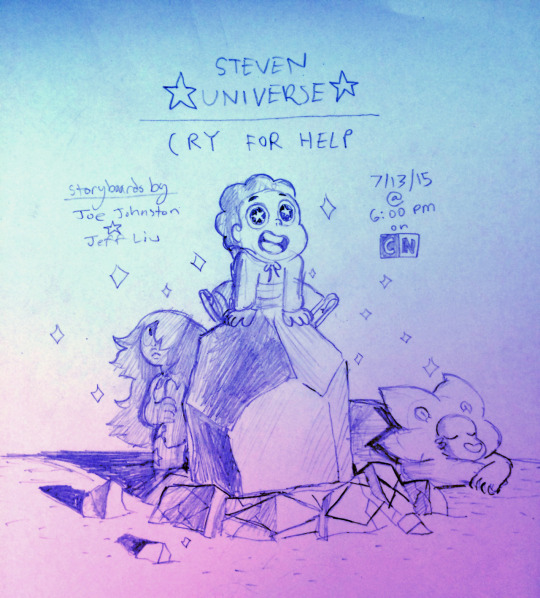
“I don’t understand.”
Pearl has done some awful things in Steven Universe. She nearly kills Steven in Space Race, and even if we ignore the rocket malfunction, her plan was to steal him from Earth for fifty years under false pretenses. She nearly kills Steven again in Rose’s Scabbard through inaction during a fit of furious sorrow. She indoctrinates Connie to see herself as fodder to be sacrificed at a moment’s notice. And she only apologizes in one of these cases.
Before Cry for Help, the show seemed pretty lax with Pearl’s tendency to lash out at others when in pain. While her grief explains her harmful decisions, it also appears to excuse them: most of our focus is on the suffering leading to her actions, not the victims of these actions. Steven comforts her every time she endangers him or his friends, which is nice of him, but suggests that his own feelings are secondary to hers.
It’s honestly reminiscent of Island Adventure, where the show refused to acknowledge the severity of Sadie’s physical and mental abuse. The difference is that Pearl is shown to be in the wrong, while Sadie is portrayed as a hero despite abusing Lars, but it’s still troubling to see Pearl more or less get away with hurting people on a recurring basis.
But it was all a glorious ruse. The Week of Sardonyx is here, groundbreaking for its depiction of a brutal rift that has almost nothing to do with the show’s title character, taking full advantage of the Steven Bomb format to tell a long-term self-contained story about what happens when Pearl finally gets called out for her toxic behavior.

If this story arc was condensed to a single episode, we would certainly spend it watching Pearl and Garnet. But with extra time to set the tone and understand the stakes, we instead see Pearl’s instigating betrayal from Amethyst’s point of view as the latter faces similar fusion woes. The focus on Amethyst is absolute (she even gets a song!), and it makes Pearl’s actions sting so much harder when her perennial rival’s reaction isn’t anger, or glee at the opportunity to tattle, but a deep and heretofore unseen discomfort.
Amethyst, who uses motor oil as a condiment and hoards literal garbage, is ashamed of Pearl. But even so, she comes to Pearl’s defense after outing her deception, because unlike Garnet she can understand the rationale behind Pearl’s actions: Amethyst and Pearl both see Garnet as strong, and themselves as weak. Amethyst misses being Sugilite, conflating fusing with Garnet as a means to share her strength, so she gets why Pearl misses being Sardonyx.
In a conflict between Pearl and Garnet, the most obvious approach is to have our third Gem act as a mediator, but I’m so glad the show developed Amethyst to fit organically into that role. Not just because she’s secretly the most sensitive Gem, or because she understands Pearl without condoning her behavior, but because she’s spent Steven’s whole life as a bridge between him and the other Gems. When you’ve got two close friends coming to a head, there’s nobody better to have in your corner than a middle child.
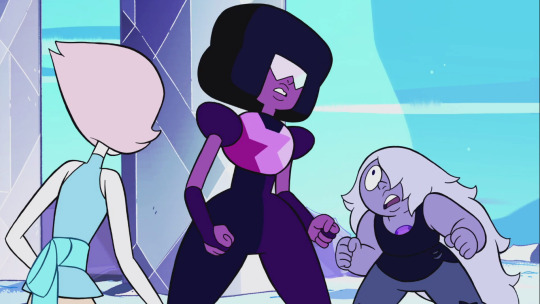
Amethyst's other big role is as a counterpoint to the notion that being sad excuses selfishness or cruelty. Cry for Help encapsulates the series-wide reactions that Pearl and Amethyst have had to sorrow, and seeing both at the same time removes any doubt that Pearl's approach is unhealthy, even if Amethyst’s is far from perfect.
When Pearl gets especially sad, her self-loathing fuels her self-centeredness until she stops caring about how anybody else feels. This is obviously bad news for the people around her, but eventual remorse over her actions fuels her self-loathing even further, and the fire just keeps burning. Everybody loses when Pearl is sad.
But look at what happens when Amethyst is sad in Tiger Millionaire, On the Run, Maximum Capacity, and Reformed: her first response is to show off, usually to Steven. She longs to be included, to be looked up to, so she becomes hyper-aware of how she’s perceived. She plays up the attributes she desires in herself (respective to those episodes: strength, belonging, the ability to chill out without thinking about sad stuff, and a better sense of self) in hopes of hiding her vulnerabilities. Or perhaps just to cope? I wouldn’t want to get all psy-cho-logical on her.
Amethyst and Pearl both struggle with self-esteem. And their actions have some overlap: Pearl taking Steven with her in Space Race sounds like something Amethyst might do, and Amethyst ignoring Steven to hang out with Greg in Maximum Capacity sounds like something Pearl might do (minus Greg, of course). But the intents that prompt these actions are night and day. Pearl wants to punish herself and Amethyst wants to feel comfortable with herself. Pearl is depression and Amethyst is anxiety.
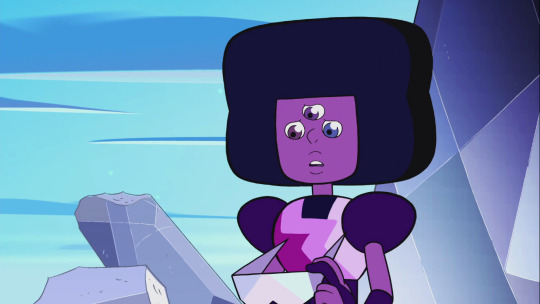
And then we have Garnet, whose healthiness has always been portrayed as a universal positive. She’s strong in every sense of the word, which is great, right? It makes her the bedrock of the team, and gives her an ironclad sense of right and wrong with the conviction to back it up.
But it can also make her oblivious to suffering.
Nothing excuses what Pearl does to Garnet (which we’ll get to, don’t worry), but Cry for Help is part of a long line of episodes displaying the downside of Garnet’s strength: an inability to understand what it’s like to be weak, leading to many moments of callousness that honestly remind me of Pearl at times.
Remember how in Serious Steven she thinks plowing through the dungeon is the best option, even though Steven is clearly rattled? Remember how in Beach Party she’s incapable of caring about wrecking the Pizzas’ sign? Remember how in Monster Buddies she can’t see that her gauntlet is what’s bothering Centy? Remember how in Warp Tour she’s more interested in humoring Steven than taking his worries seriously? Remember how in Love Letters she prefers absolute bluntness to a polite but firm rejection? Remember how in Reformed she gets aggravated with Amethyst instead of exploring the root of the problem, leaving it up to Steven to figure it out? Remember how literally one episode ago in Chille Tid she ignores Pearl’s pleas to help out? Is it really any wonder she can’t see that Pearl and Amethyst are upset in Cry for Help?
This is a huge gap for a character that’s all about understanding, and it’s the reason the Week of Sardonyx is important for Garnet beyond making her a victim. Spoiler alert for Inside Out, but sadness is critical for nurturing empathy, and Garnet's general lack of sadness can make her miss when her friends are upset without...well, without a cry for help. There’s a reason it takes defusing into Ruby and Sapphire for her to start processing what happened to her, because Ruby and Sapphire are a lovable bundle of neuroses next to Garnet’s cool calm.
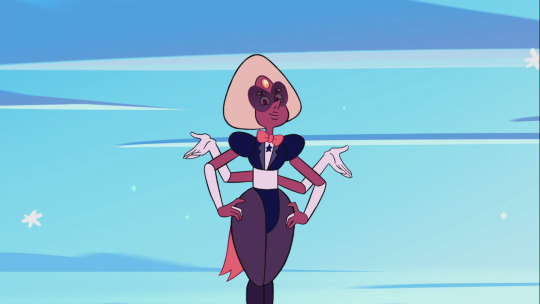
But there’s also a reason defusing into Ruby and Sapphire doesn’t directly lead to Garnet forgiving Pearl, because holy shit Pearl. Once again, fusion’s value as a multi-faceted metaphor is crucial to the tone of the show: there’s plenty of sexual innuendo to it at times, particularly in Cry for Help’s dances, but the fact that it stands in for relationships in general instead of just sex is all that prevents Pearl from being a literal rapist. Not only is consent important, but we were explicitly reminded of this only three episodes ago in Keeping It Together. It would’ve been bad enough if Pearl did this with Amethyst or Steven, but Garnet is particularly concerned with consent in regards to fusion.
Cry for Help tones down the drastic implications of Pearl’s betrayal by giving Garnet a somewhat childish initial response (“You tricked me!”), but from there it pulls no punches portraying Garnet’s righteous fury. Amethyst’s defense only makes her angrier, because it doesn’t matter if Pearl had a motive for fusing with her under false pretenses, and it doesn’t matter that Pearl feels bad about it. Even if it isn’t read as sexual assault (and I genuinely don’t think it’s meant to be, given how the situation resolves), Pearl’s actions are a violation of Garnet, their relationship, and fusion itself. It’s the dark side of the insecurity that fueled the longing hopefulness of sister episode Coach Steven, and it packs the biggest emotional wallop of the series thus far.

There’s a feeling of hopelessness to the end of Cry for Help that I deeply appreciate, because really, where do we go from here? It’s unlikely that the show would break up the Crystal Gems permanently at this point, but there’s also no real reason for Garnet to ever trust Pearl again. Garnet’s still mad (and she should be), Pearl’s a wreck (and she should be), and Amethyst and Steven have no idea what to do. Cliffhangers like this are rare on Steven Universe, but it does so well at capturing the awkward, awful aftermath of a friend wronging a friend.
Because despite all of this, Pearl is still Garnet’s friend. And I’d argue that despite all of this, Pearl is still a good person. In fact, I’d argue that Pearl being a good person is the most important thing about the Week of Sardonyx. It’s easy to tell a story about a bad person doing a bad thing, but most people see themselves as good, and most people have done at least one bad thing. If we write Pearl off as a monster and leave it at that, what room is there for us to learn? If doing one horrible action is enough to make you a villain, what hope is there for anyone?
I say this while knowing that I’m actually pretty quick to condemn people forever for certain actions: namely, try as I might, I struggle to see any reason for any rapist to be allowed to live. Like, to the point where my first wish if I ever nabbed a genie would be for every rapist on the planet to vanish and get replaced with a note that says “Don’t mourn for me, I was human garbage.” (Obviously there would be many footnotes for this wish; for instance, if a rapist is a pilot I don’t want to endanger folks on a flight, so extra magic would have to intervene. I have really thought this out, I got the footnotes all set, I am ready to find a genie.)
If that’s how I feel, how is it that I have such empathy for Pearl, even though I’m completely on Garnet’s side? It’s not that she’s fictional, because I’m not huge on fictional rapists either. And it’s not that her action isn’t actually rape, because it’s still a gigantic violation. So I honestly don’t know. But Steven Universe is capable of making me examine how I view the world in a way few shows can, and even if I don’t think the Week of Sardonyx quite sticks the landing, the opening is appropriately wrenching stuff.
(With funny weeping foodstuffs to keep the younger audience from getting too upset. Not the subtlest subtext in the world, but I’ve got no beef with kids’ shows keeping things grounded for kids.)
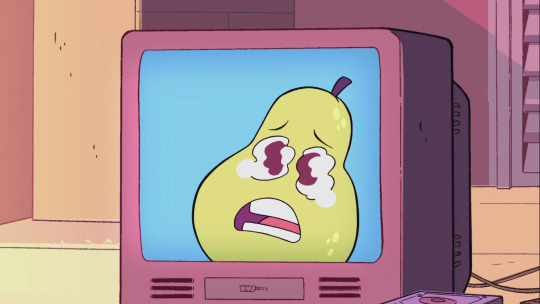
Future Vision!
Nothing too direct, but the Week of Sardonyx’s angst returns with a vengeance in the Breakup Arc immediately following Wanted. Multiple episodes of working through an argument? Check. A sense of betrayal involving fusion? Check (sorta). A resolution brought about by a common enemy? Check. The biggest difference (beyond the shifted focus to Steven) is that the Breakup Arc is more invested on making you miserable on an episode-by-episode basis, making it even harder to watch. Want a break from Steven and Connie not talking? Have a secondary breakup between Peridot and Lapis!
Pearl’s similarity with Spinel makes the movie’s exploration of a suffering Gem’s toxic reaction to pain a fascinating companion piece to the Week of Sardonyx. The major difference is that Pearl hurts others due to selfish thoughtlessness and Spinel’s goal is hurting others, but both have great reasons to feel terrible, neither has a great reason to inflict this pain upon others, and both need to make a change.
We’re the one, we’re the ONE! TWO! THREE! FOUR!
This is the episode in my “Love ‘em” category that I’ve watched the least, because it’s a tough one. I more appreciate Cry for Help than enjoy it, because it’s not meant to be enjoyable, but it’s still worth putting up there because man does it nail the tone.
Top Fifteen
Steven and the Stevens
Mirror Gem
Lion 3: Straight to Video
Alone Together
The Return
Jailbreak
Sworn to the Sword
Rose’s Scabbard
Coach Steven
Giant Woman
Winter Forecast
Chille Tid
Keeping It Together
On the Run
Warp Tour
Love ‘em
Laser Light Cannon
Bubble Buddies
Tiger Millionaire
Lion 2: The Movie
Rose’s Room
An Indirect Kiss
Ocean Gem
Space Race
Garnet’s Universe
The Test
Future Vision
Maximum Capacity
Marble Madness
Political Power
Full Disclosure
Joy Ride
We Need to Talk
Cry for Help
Like ‘em
Gem Glow
Frybo
Arcade Mania
So Many Birthdays
Lars and the Cool Kids
Onion Trade
Steven the Sword Fighter
Beach Party
Monster Buddies
Keep Beach City Weird
Watermelon Steven
The Message
Open Book
Story for Steven
Shirt Club
Love Letters
Reformed
Rising Tides, Crashing Tides
Enh
Cheeseburger Backpack
Together Breakfast
Cat Fingers
Serious Steven
Steven’s Lion
Joking Victim
Secret Team
Say Uncle
No Thanks!
4. Horror Club
3. Fusion Cuisine
2. House Guest
1. Island Adventure
51 notes
·
View notes
Text
A Professional Practice: Graduate Strategies File
Contents:
1 Link to power point slides & evaluation
2 Current avenues:
- ‘Apricot to Rot {in progress}: An Independent Artist’
- Curator & Events Organiser- The 372 collective & Spike Island Coordinator
- Art Therapy Career and Volunteering
3 Future Career Plan Evidence & Evaluation
Link to Power Point
https://docs.google.com/presentation/d/1nkruGAGsBUJtVLIEc14-UcM0OEtI8TyDUPfYF5qpd8U/edit?usp=sharing
Evaluation
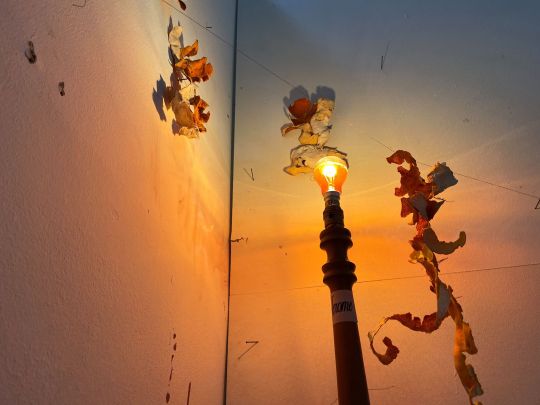
Looking through my presentation now, seeing the work I was making at the beginning of this project, the visions I had for what this module might be... It is beyond what I imagined. I’m writing this after spending so long in lock down I don’t know how long its been and life at Spike Island seems hard to fathom. Although I miss Spike greatly, in many ways I think think lock down has given me an experience of making that is totally unique and through this it has transformed the work greatly, I think for the better.
In the presentation when discussing my current work I focused on how I wanted to grown my archive, and how I set out to collect and gather, far/wide and near by. At the time of the presentation my work was dictated by text, although I now realise the words have become an equally woven part to the archive; a component that informs the objects as the objects inform the words. I seem a more developed and experienced practice of techniques with the relationship between text and the other medias. Through the greater importance of the curative environment the parts have become connected, thus allowing loosely for objects to speak a narrative in their symbolic presence. Narrating more so through objects than the words has allowed the text to become more ambiguous. I feel the less informative sensory stories of memory and other themes allows the audience to come on their own journey with me.
I have continued looking into some of the artists or themes within my research back when I did the presentation. I had a great interest in artists who dealt with hospitalised bodies and works that emulate or incorporated bodily experiences. This led me to research around the idea of the decrepit and thus led my interest in collecting and ‘framing the decay’ and treating the broken with fragility. Since the last module, the work has evolved through new avenues of photography and the importance of curation and thus how structures and reflections within these can narrate my themes through the archives in subject. I hope to continue researching around relational aesthetic art.
When making the presentation I was at the beginning of planning these collections, where I would go, what I might hope to find... Through this I wanted to shift the 30 credit module into new themes. The work has grown through moving between transforming concepts around ‘domesticated-ness’ that have carried the collection to integrate with and place under the magnifying glass- the mundane. How do we see things, how do we see differently from each other and what is seeing if not experiencing.
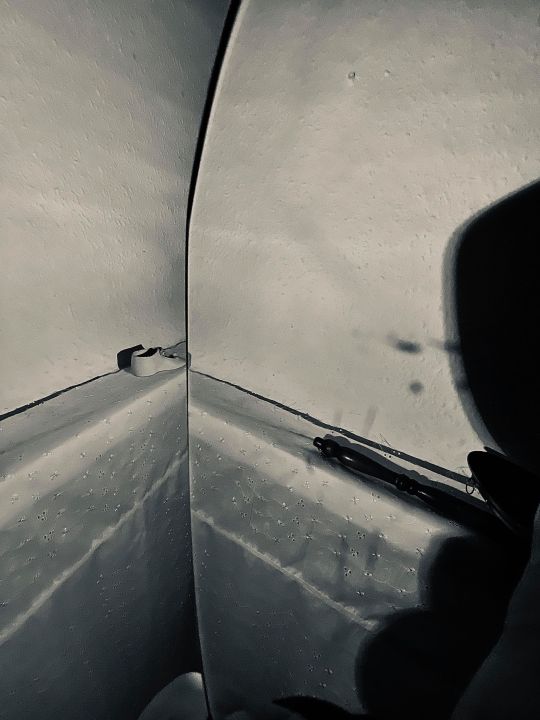
I am feeling very fulfilled to have made so much progress with the collection I set out to create and how the work has evolved and the exciting prospects of splicing these with sounds. I will continue widening this archive and finding ways to curate them in spaces including digital space, books, places, exhibitions... Now turning to the career aspect of the presentation...
At the time I had undertaken a lot of exciting responsibilities, in particular the role of coordinator for level three and training for an arts facilitator session through St Mungo’s Homeless Charity. On the evening of the presentation I reflected on how I felt I did, I felt I didn’t have much to show for the art making but I had lots of plans to discuss. I felt very excited with where it was going and the possibilities as it was about to take of. However, for the career side I felt there was a lot I didn’t say. It was the part of the presentation I felt most excited to discuss and possibly the pressure I put on myself to talk about it almost made it difficult to fully translate the lengths of my passion and efforts. I guess the lack of visual aid didn’t help when referring to the the presentation, but it was pretty impossible to include pictures. I think I didn’t give enough of a platform in the way I discussed it and its presentation on the slides when in fact both the art therapy and the coordinator role were two things I felt very strong about and was putting a lot of energy and soul into it. I’m not sure... When presenting things dear to my heart I often loose the outline of my body and find it hard to be sure of what I did or didn’t say.
I feel like I have accomplished a lot since this presentation. I have completed all of my training including additional training for the prospects of learning to work in an arts therapeutic role. I have worked in a complex needs hostel running my own sessions and I joined a team for the Drugs and Alcohol Recovery College at St. Anne’s facilitating art groups. This is something I am keen to pursue further and although this year has been very demanding I am in a position now where I feel my efforts have set me up with new possibilities. Additionally, the experience and connections I have made through being the coordinator with Erin and Esther has enabled my full involvement with Spike Island peers, events and tutors. Spending most days at Spike has allowed me to be full immersed and develop connections that I hope to carry through.
Current Avenues, ‘Evidence of Future Plans’
In many ways my practice is a true reflection of my personality and what I seek in life. I don’t want to be limited within one career when there are many avenues I am keen to pursue. Thus, my many interests in life seem to combine into one globular paradigm, this is equally mirrored in my use of varying mediums and concept based art work and my taste in music. This multi meaning and substance encompassing practice I have developed is a reflections of my equally expanding and shifting interests in many other aspects of my life. Reflecting on this, I decided to focus my efforts and developmental skills within three specific fragments as a way to develop my skills and progression towards a career that can encapsulate some areas of my varying interests. Thus the following is split into three segments of current avenues:
- Apricot to Rot {in progress}- An independent artist
- Curator & Events Organiser- The 372 collective & Spike Island Coordination
- Art Therapy
Within each section I shall be discussing, analysing and reflecting on my aims to peruse and develop these areas during the past year and looking towards the near future. In addition to this, I will discuss the current situation of Covid-19 in terms of successfully continuing my future career plan within these constraints and the implications of these limitations.
‘Apricot to Rot {in progress}: An Independent Artist’
- Artist Instagram account
- Covid-19 limitations and planning
My original vision with becoming an Independent Artist has been some what delayed in terms of selling works as I am unable to produce and distribute during Covid-19. However, working to exceed these constraints I have recently focused more on elevating my online presence. I have created an art account on Instagram to advertise my work so that once I have access to facilities I can set up my website again and continue selling prints.
372 studio

26/3/2020 Image: Screenshot of Artist Instagram account, displaying my zine page segmented into 15 images.

18/5/2020 Screenshot of Artist Instagram account
In addition to my Instagram, after submitting this Tumblr account I hope to create another account into a professional space that displays ‘digital books’ of images, sounds and texts for isolated listeners. I think my work is very suited to the formats of installations of photography ‘books’, but I have been unable to produce any in physical form because of limited access to facilities and equipment. Therefore, I am very keen to continue making whatever work I can and use my Tumblr as a space to almost digitally plan the works that I will one day publish in a physical book. I hope to make these digital spaces as immersive as possible and try ensure the digital aspect of it doesn’t change the narrative too much.

11/4/2020 Screenshot of Artist Instagram account
Research into Digital Books See under DIGITAL BOOKS/ PUBLICATIONS RESEARCH
Curator and Events Organiser
372 Collective
For the past year I have been developing an art/music collective residency at 372 with ten other artists and musicians {including many more who have passed through}. We have decided to stay for another year, for me this collective is integral to being an artist as it gives me the space, peers and creative city that allow me to be fully submerged in setting up myself as an independent artist and forming this collective. Before the out break of Covid-19 I was running events and exhibitions almost every other weekend with the collective at 372 and my plan was to continue running these as a main source of income through this next year however this may not happen quite as I envisioned but the show must go on. My vision is, to get events and exhibitions back on- to give up coming independent artists a space to exhibit work, collaborate, showcase and create and a space for the collective residents to curate and present their work.
6 month Calendar I have created for residents-
Art Based Residents: April Kirkwood, Sadie May, Sylvie Whitfield, Anna Young, Ashleigh Swain, May Bell, Katya Skyes, Charles, Toby George, Oli Camp, Joe Camp, Max
June Aims: Transform the garden: Build plantiers, wormary compost, risen beds, water system, Grow our own vegetables. With aims for 372 to be a communal and fully sustainable place with our own fresh fruit and vegetables all year.
Repaint house areas- fresh vibes! Enquire for paint from land lord {end of may}
July
Week One: 4 new residents {Ashleigh Swain, Anna Young, Oli Camp, Joe Camp} Walls to be painted in personal spaces, communal areas.
Week 2: Discuss Covid-19: how can we utilise this collective when on lock down, digital exhibitions, publications, use event spaces as studio spaces, apply for group funding/ research opportunities.
Week 3: Turn the Basement into a transformable studio space so that artists have a space to make work which we can still use for events and exhibitions.
August Aims:
. Move into basement
. Create one croup art work
. Hold an exhibition {for exhibition plans see section 5}
September {Lock down lifted?}
Week one: Organise an in depth Calendar: When do people have work, university deadlines. When can we do Events. Create off limit days on a calander.
Week two: Social Media take over! Using the social media account I created this year, document everyone's work at 372 and post about up coming exhibitions and opportunities to curate/ rent / attend the space.
Week 3&4: Everyone split in 4 groups to plan a different exhibitions running everyone other weekend from October- November. Roles and responsibilities to consider: sound system, decorations, event staff, bar set up, call out posters, clean up team
October: {information to be added} Names of artists, themes, name of exhibitions, roles, equipment needed
Group A Exhibition {Week 1}
Group A Deinstall/ Clean {Week 2}
Group B: Exhibition {Week 3}
Group B: Deinstall/ Clean {Week 4}
November: {information to be added} Names of artists, themes, name of exhibitions, roles, equipment needed
Group C: Exhibition {Week 1}
Group C: Deinstall/ Clean {Week 2}
Group D: Exhibtion {Week 3}
Group D: Deinstall/ Clean {Week 4}
December/ January Performance Month: Transform the basement into an immersive space used for a ticketed night(s) of performances: sound system, decorations, event staff, bar set up, performers, scripts, costumes, call out posters, clean up team
Artist CV:
Ebony A Wray/ Apricot to Rot
Tumblr: Apricot-To-Rot
Instagram: EbonyAwray
Email: [email protected]
Artist Statement
I am a ‘visually challenged’ independent artist, part of the 372 residency in Bristol UK. I am a collector. I gather fragments, ‘bits’; these bits can be sounds, rubble, discarded plans, disembodied parts, words or objects. The work questions boundaries between ideas, emotions and objects through space, narrative and sound. My practice is multi-dimensional, dealing with installations, sculptures, photographs, sounds, film, painting and poetry. Too access this archive of work please see my social Media or request my documentation file via email.
there are no installations- only words, there are no sculptures- only sound.
Education
Fine Art A-Level, York College 2015, Grade B
Fine Art Foundation Diploma, York College, 2016 Grade Distinction
Fine Art BA Hons Degree, The University Of The West Of England, Present
Exhibitions/ Curation
Tits and Bits, 2019, The Flat . Curated by Clara Troy. Role: Life drawing model & Sketcher.
Whoever was using this bed, 2019, The Flat. Curated by Clara Troy, Isaac Jordan & Alis Toe. Work exhibited: Tea cup Rabbit Spatula, 2019, Painting, 1m x 1.7m. Untitled Sketch book works, 2019.
Trust Absolute Unconditional, 2019, The Crypt. Curated by Leah Wellington. Work Exhibited: Untitled, 2018, Sculpture, Dimensions Variable.
Callaborative Painting UK, 2019, Kosar. Work Exhibited: Untitled, 2019, Painting on Canvas, 1m x 1m. Untitled, 2019, Painting on Canvas, 5.3m x 1.6m.
Fine Art Fright Night, 2019, Spike Island. Role: Coordinator & Curator of Events Managment. Work Shown: How to Mourn An Orange, 2019, Installation, Mixed Media, Dimensions Variable. King Barry, 2019, Performance, Costume Design, Make-Up, Cat walk model.
80s! Prom Fine Art Fundraiser, 2020, Spike Island. Role: Events Coordinator.
Take Two Fine Art Fundraiser, 2020, 372. Role: Events Coordinator.
Curator and Events Organiser
In this section I will be providing Visual documentations as evidence for the events that have taken place at 372. This section will continue to discuss similarly my role as coordinator of events and fundraising for Fine Art Level 3. This sections aims to demonstrate my efforts throughout this year in developing skills to equip my future career plan in terms of curating, organisations and fundraising music events and exhibitions.
372 2019-2020





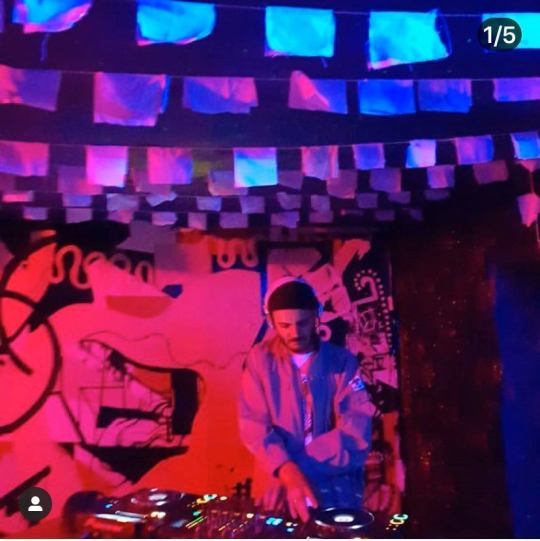

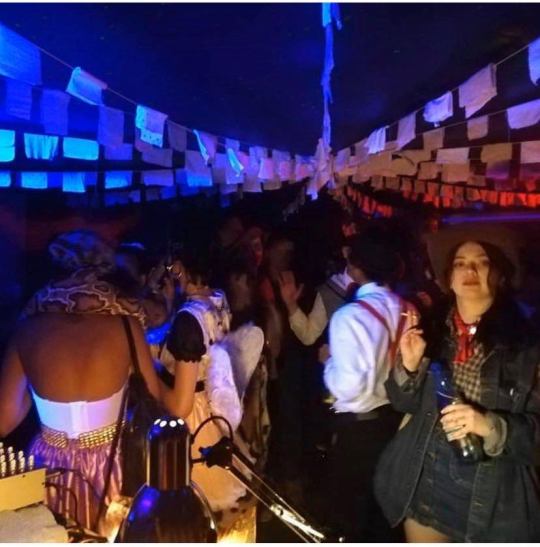

Coordinator Level 3 UWE
This year I had a joint role of coordinator with Erin and Esther. I took the lead in coordinating for the first half of this year, and I have also ran fundraising events at 372. Through the events at 372 me and Sadie organised a Bursary scheme to offer students unable to pay the £50 degree show entry a free ticket to curate their work. However, since covid this money has been contributed towards an online degree show. My role as coordinator was to ensure the connectivity between each member of the team, to record all information and act as a point of call for any queries within the organisation of all events. I took more of a lead role within coordination in the first half of the year. My main hope was to form a connected group on level three through encouraging people to contribute creative ideas and take of roles within the fundraiser events. I wanted all creative voices to be heard and so I spent a lot of time ensuring and supporting everyone's contributions came to fruition. Looking back now I am very proud of these events and my efforts because I wanted to create a series of exciting events at Spike and bond the year to combine everyone talent.
Planning meetings, organising roles and keeping track of information to chase people up with their jobs:



I leased with Wayne and other tutors, musicians and accessed tech support for these events. I ensured everyone working at the events understood the health and safety procedures and kept to the licensing. I bought and transported all the alcohol and used my knowledge of bar work to run a cheap but efficient bar with trained staff.
Social Media control and encouraging the group to engage:
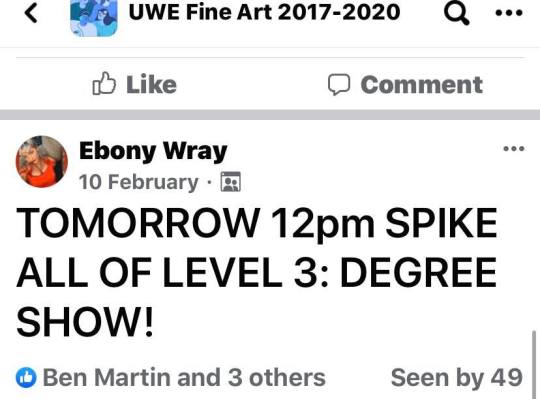



Link to rota for events I created:
https://docs.google.com/spreadsheets/d/1eVUXUOf71-J2GYIz4hD5dzNesCW_5xJmly6ZeVvDXUg/edit?usp=sharing


Link to Power Point Lectures I held:
https://docs.google.com/presentation/d/1yzB5pouN0jlWI-xkKe5cbu9hIUdM8XuKpdb28hmWzRc/edit?usp=sharing
During the events I took on a multitude of roles, including; First Aider, overseeing the bar, ensuring the change and cash flow of the bar through Beckie and our bar team. I would greet all the event goers by standing on the front door and introducing them to the event. I would be the point of call for every team member on the night, ensuring the time plan of the night was kept to and solving any issues and pointing people to the right person to talk to. Finally, I made sure Spike was left in a clean acceptable condition with everything recycled.
As the year has continued, I have spent an increasing time in hospital so I took more of a back seat within the coordinating. Esther and Erin did a fantastic job with organising the publication for the degree show and as a group with Beckie we did a lot of expenditure planning for how our fundraiser money would be spent on an ambitious and innovative degree show. My role was to still ensure all voices were heard in the creative decision making and the decisions around democratising how the fundraising money was spent. I held a series of discussions, power point lectures and workshops for all of Level 3. I recorded this and then me Esther and Erin made the final decisions on where money would be spent most effectively.
My main hope in doing all of this was to get some really exciting events happening at Spike with the importance of inclusivity by getting as many people involved as possible. I am very proud of the events, I learnt a lot and have made a lot of connections through doing so.
Event Pictures:
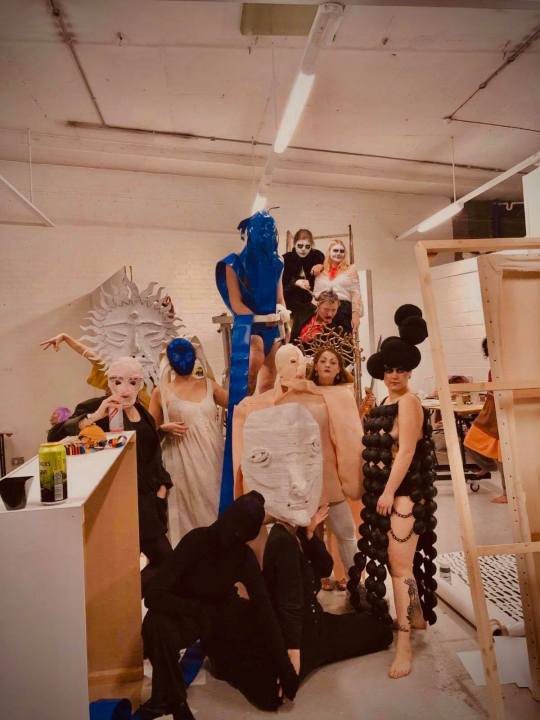
Spike Island 31/10. Catwalk Models Pose for group photo. Models: Ebony Wray, Clara Troy, Alis Toe, Ashleigh Swain, Joel Mansfield, Lucy Mardell, Fran. Todd Clarke and Sadie Arellano.

Spike Island 31/10. Set Design and Installation work by Ebony Wray and Daisy Jones. Face Painitng workshop.

Spike Island 31/10. Ebony Wray Installation Performance.

Spike Island 31/10. Ebony Wray Installation.
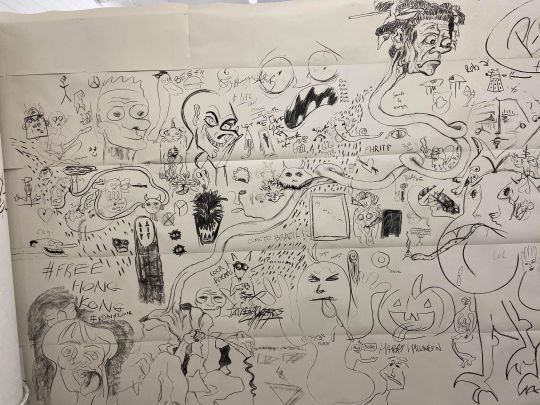
Spike Island 31/10. Set Design: Sheets of paper for event goers to draw illustrations.

Spike Island 31/10. Photograph: Ebony Wray. Model: Sadie Arellano, Catwalk Costume.

Spike Island 31/10. Sadie Arellano and Barry {Ebony Wray}

Spike Island 31/10. Barry {Ebony Wray} and April Kirkwood

Spike Island 14/2. Exhibition space.

Spike Island 14/2. Dance Floor, Projections and set desin by Diasy and Ella.
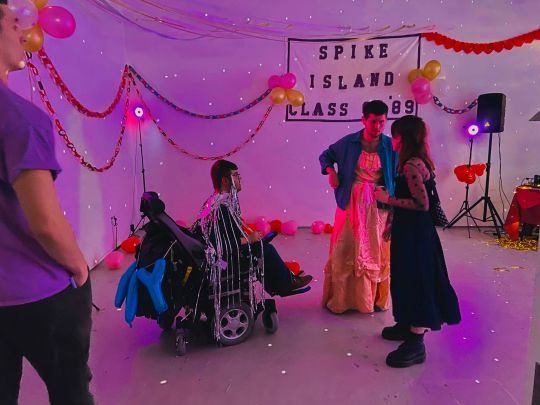
Spike Island 14/2.
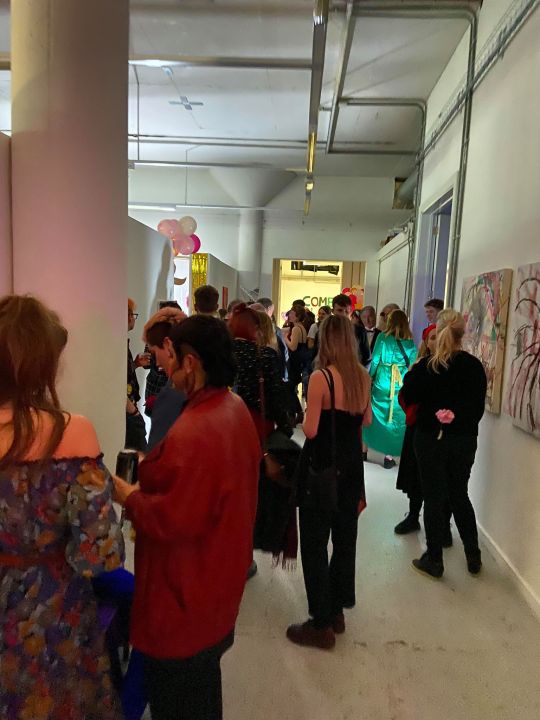
Spike Island 14/2.
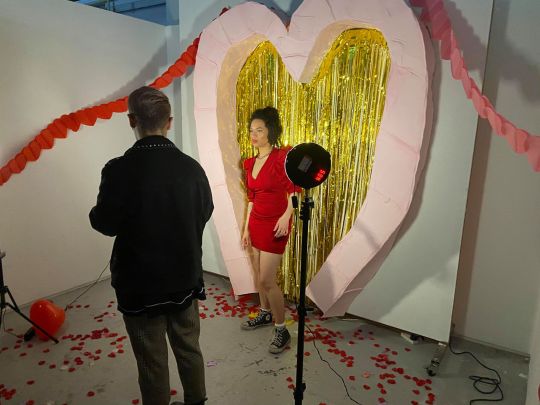
Spike Island 14/2. Photobooth made by Loulou Jane and Daisy Jones.
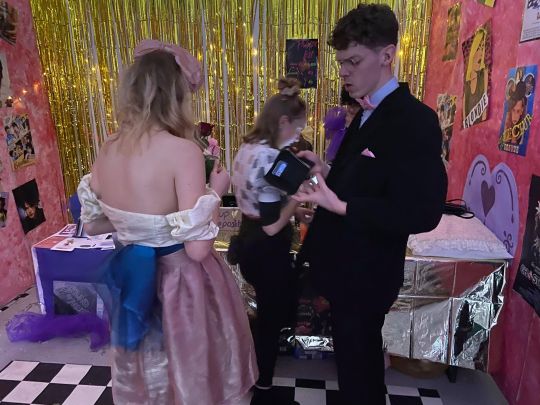
Spike Island 14/2. Bar area.
Art Therapy: A Vessel for Self Expression
Before studying Fine Art I placed great importance on the ideology of using creativity as a way to heal and enrich the self from experienced trauma. My passion for this has always drawn me to explore a sense of underlying self within poetry, collecting and story making. Although my practice usually explores a multitude of important concepts such as the notion of home, nostalgia and uncomfortability... The underlying cathartic release is the integral experience that continues my growing practice. My interest in this relationship between therapeutics and Fine Art is what has led my sought training and PPWE research this year; with the aims to develop basic skills and knowledge to equip me for progressing into to the industry of Art Therapy.
[Due to Covid-19 complications, the ‘evidence’ of my efforts to develop these skills will be presented within six screen shots of emails between myself and my employer.]
I went to the UWE Frenchay employment and volunteering fair in November and through this learnt about St Mungo’s Homeless Charity. Since then, through this charity I applied for my DBS check and have undertook a multitude of training programmes. I then set up my own art based group in a complex needs hostel.
Training completed:
Core Training
Mental Health Training
Conflict Resolution Training
Complex Trauma Training
Borderline Personality Training
Shadowing existing session





Setting up the Art Group

Longhill’s complex trauma hostel St Munngo’s: I gained a lot of experiences and knowledge from running these sessions. My next step after this was to join another existing team doing art sessions at The Drugs and Alcohol Recovery College, starting on 27/4/2020.
Covid-19 complications:
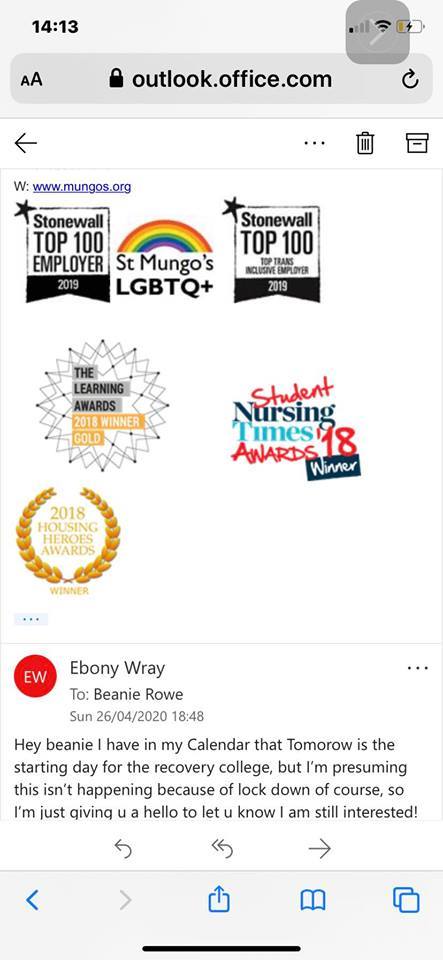
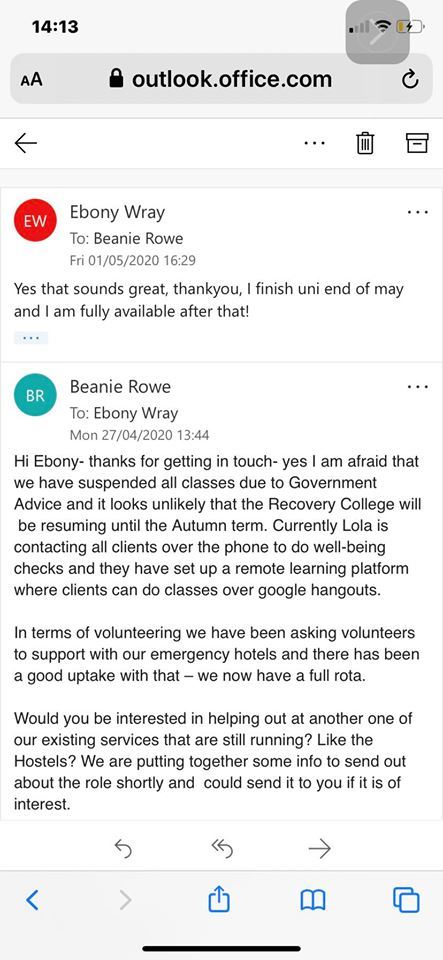
Since Covid-19 I have been in contact with St Mungo’s and I plan to return after the 26th of May. I hope to progress within this charity to develop a career within care that can involve therapeutic art practices for vulnerable people.
Additional Evidence of Future Plan
Future future?
UWE Bristol Postgraduate Santander Scholarship of £4,000 to continue full time post graduate study in September 2020. {Deadline 19th June) Waiting for feedback on draft submission to 'My Questions' on InfoHub {Curating MA, One year course.}
DLA for Adults Application
Evaluation of Future Plans?
Throughout my reflections on current possible avenues I have already evaluated at lengths the three avenues my efforts have gone into persuing these. The Art Therapy role through St Mungos’s, my interest in curation and running events and finally being an independent artist. Advancing on what has already been said, I find it hard to fully create a water tight, logical future plan right now for a society that is constantly changing. My health and abilities are constantly changing and the many innovative opportunities that may arise in the end couple of months are hopefully unimaginable as I’m sure exciting new roles will arise for me. So, with that said I think the plans I have discussed is the best I can provide right now. I am looking into applying for DLA through the government to support me throughout my hospital endeavours. Becoming visually impaired has massively impacted my life and my sight is constantly changing like the world is right now, so I will just have to take life as it come. I am passionate about following these three avenues through and I will think about the curating MA. It is tempting because it is free although I think the opportunities I already have lined up this year are overwhelming and a masters in art psychotherapy in later years would be better suited to me. I will continue to keep my ears open for open calls and I really am passionate about making exhibitions happen this year at the residency.
0 notes
Text
INITIAL RESEARCH INTO PLAY
‘Deeper than gender’.....‘seriously, but dangerously fun’ – New York Times
The type of play I will investigate further is ‘Free (spontaneous) Play’. Free Play is the freedom to act creatively in any way for self-enjoyment, without fear of judgement or for an end goal.
In this blog I want to investigate the connections between play, creativity and art and design. I believe that all forms of art and design are an extension of play. I want to explore the idea that in the future play could be revered above economic concerns and that society could take advantage of technology in the future to allow people to enjoy playing.
To play
1. engage in activity for enjoyment and recreation rather than a serious or practical purpose.
- amuse oneself by engaging in imaginative pretence.
- engage in (a game or activity) for enjoyment.
2. take part in (a sport).
3. be cooperative.
- fiddle or tamper with.
4. represent (a character) in a theatrical performance or a film.
5. perform on (a musical instrument).
6. move lightly and quickly, so as to appear and disappear; flicker.
Play in childhood:
Through carrying out my research I have found many ways of thinking about play, one of which is to see it as solely a children’s activity. Stuart Brown, author of ‘Play’, states that ‘Play is seen as a rehearsal for adult activity.’ He suggests that this belief is ‘powerfully wrong.’ The conversation surrounding play is that most often it is referred to as being a separate activity, not something to be mixed in with everyday life.
Children gain knowledge through their play. They exercise their abilities to think, remember and solve problems. Play is performed for self-amusement and it has behavioural, social, and psychomotor rewards. It is child-directed, and the rewards come from within the individual child; it is enjoyable and spontaneous. Play in childhood is important for our survival. It teaches us about the world by learning through cause and effect. Child psychologist Margaret Lowenfeld believed that children were better able to express themselves through play than words. It has also been shown that exposure to metaphor and symbols, as used in play, has a beneficial effect on the development of the brain.
There are different types of play:
Physical play - exercise
Expressive play - drawing, playing instruments,
Manipulative play - master their environment - object
Symbolic play - symbolise child’s feelings
Dramatic play- act out situations
Familiarization play
Games - rules
Surrogate (spectator) play - watching others play
Play in adulthood
When we grow into adults, we are encouraged to lose the sense of play and become more aware of other people’s opinions and their judgement of childish behaviour. When people see me playing around in one way or another I am told to ‘grow up’ or ‘act my age’ by adults. This prohibition on play in adulthood becomes shockingly apparent when my friends stop question themselves when playing - “what are we doing, we are 19 years old, this shouldn’t be happening’
In Tim Brown’s Ted talk ‘Tales of Creativity’ he performed an experiment with his audience members - a 30 second drawing task to draw the person next to each member of the audience. The audience members then showed the drawing to their partner and there was a lot of laughter and a lot of people saying sorry. Brown stated this was evidence that we fear the judgement of our peers and this fear is what causes us to be conservative in our thinking. When children underwent the same experiment they were not embarrassed.
This experiment demonstrates a loss of the freedom to express ourselves without the fear of judgement we had as a child. By editing our ideas and playful thinking when adult we no longer take creative risks. The majority of adults give up play for other pursuits such as careers. An adult life is stressful and busy. The rejection of play in our relationships, professions, alone time means we are not inducing the pleasure that play gives people.
In our society the opposite of play is typically seen as work. However, Stuart Brown argues that the opposite of play is depression. He argues that our species has evolved to value play throughout our whole lifetime.
Imagine a world without play.
Play in the future
Play could play an important part in the future of our civilisation. With technology advancing at an exponential rate more and more processes are being automated. People used to work in the fields until the agricultural revolution brought in machinery to boost production which reduced the number of manual labourers needed on farms.
The equivalent happened in the factories - the first wave of industrialisation saw an influx of the rural population move into towns and cities to work in factories. However, many factory jobs have recently been lost to machines and robots that do the same job more efficiently.
A future looms where humans become obsolete in the industrial functioning of our societies. What will humans do to pass the time? This is where we might consider something that is inherent in our psyche, beneficial to our well-being, encouraging activity and social interaction - play!

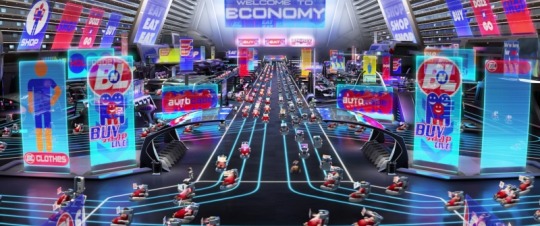
Wall-e, 2008
The film ‘Wall-e’ shows a potential future in which human life is safely in the hands of robots. The humans sit on hover lounge chairs behind holographic screens, incredibly overweight. Even now many people are inactive in front of screens. In an alternative future this time spent being inactive and vegetative could be spent active in play. Imagine that without the need to pursue time consuming and stressful careers, we will have the freedom to return to the joyous way of living we experienced as children.
Play as a thing in itself is arguably something that humans do not fully understand. It has certainly never just singularly one thing. I believe the need for play is immediate throughout our life. We need to stop separating it into thinking in terms of an action that children need and adults don’t need or of separating play and work.
Through my investigation I will see how I can have an impact on people’s lives with ideas for play and for environments that encourage play.
The Welcome Collection exhibition
The layout of the exhibition, designed by Andres Ros Soto, was inspired by the philosophy of designer Isamu Noguchi, who created playscapes that would inspire a will to play rather than dictating one to play.
It showed a historical explanation of children and play and how play has influenced society.

Isamu Noguchi (design) and Shoji Sadao (architect). Moerenuma Park, Sapporo Japan. 1988-2004.
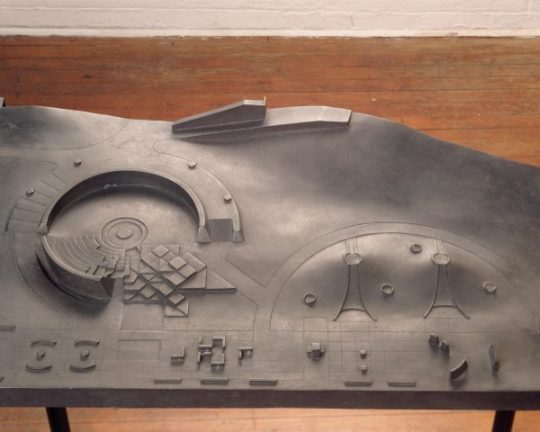


Playground Architecture
A specific play-based architecture for children has developed over the years. It began with children in Post-war Britain exploiting the existing bombed out plots of land for their own imaginative games. Children’s rights pioneer Marjory Allen, a landscape architect by profession, began the adventure playground movement after seeing junk playgrounds in Copenhagen in 1945. The Danish children made these play structures themselves out of waste material,
I used to play on my road with my neighbours as a child. We would make ad hoc structures for spontaneous play situations. I still go out and skateboard on my homemade ramps in my cul-de-sac which is a relatively car free street. A cul-de-sac or, in English, ‘dead end’ is far from dead. Cul-de-sac streets increase spontaneous outdoor activity by children because of the reduced danger from traffic.

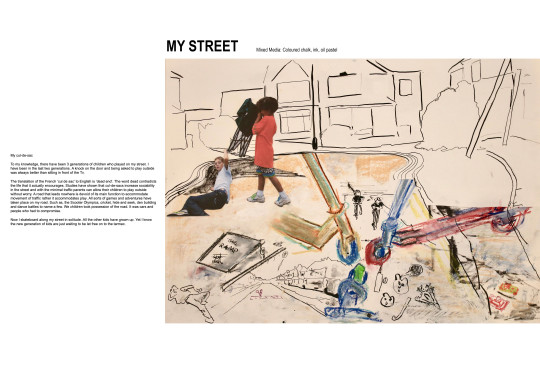
Toys
In the 20th century children often made their own toys. Children would build functioning go-carts, dolls and sling shots. Now Toy manufacturers design and make toys for children.
There is an ongoing debate on whether designed toys are better than toys that havent been designed. This debate is similar to the design of spaces and the implications they have on the imagination.
Play Club
I run an afterschool club at Kingston Foundation for anyone who wants to join. We take over the ampitheatre in the new Town House building and get involved in playing. This constitutes games, performance, improvisation, movement, singing and more. Each week is spontaneous and unplanned. The activities in the sessions come about through what people suggest, how people are behaving, and what the room on that certain occasion is offering and spontaneous ideas of how to direct a group of people.

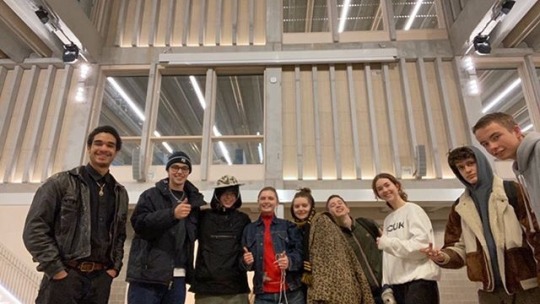
The space we are in really influences what we do and somewhat makes play club possible.
Town House - a building for play

Town House, Grafton Architects

Town House library: A stirring, open-plan library where students can ‘meet and fall in love’
The hope, says Yvonne Farrell, who with Shelley McNamara, founded Grafton, is to create “a social spiral” rising up the building, to allow the “kind of abrasion” of different people doing different things, which “is what a university is”
What makes the Town House an interesting and exciting place is the large open spaces, maze like structure, multi-levelled benches, lots of nooks and crannies - windows to the other floors so people can become an unseen audience.
Play Club has been running for 4 weeks
· 1st week - games, rules, expression
· 2nd week - more acting based, creating characters using comedy and creating narratives storytelling, pretending
· 3rd week - team challenge - communication and collecting, creating
· 4th week - improvisation
Play Club would come under what Stuart Brown would call the 'imaginative play' archetype - storytelling, painting, drawing, crafting, and acting, as well as comedy and improvisations.
Monster Chetwynd
Chetwynd is known for her vibrant, energetic and playful performances.
youtube
‘Brain Bug Performance’
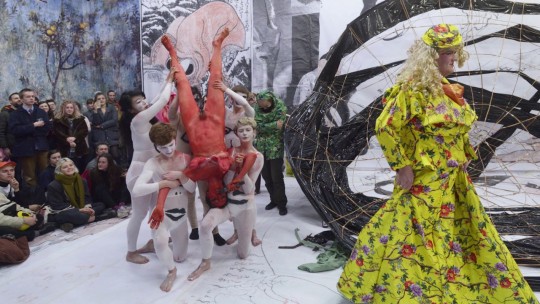
‘Uptight upright upside down’ video footage from Videodrome by Cronenberg and Woody Allen’s Purple rose of Kyro with 1700 Japanese shunga art.
Chetwynd said in an interview that, ‘amateurism in my opinion is something that’s quite refreshing’. This goes against the idea that play leads to invalid things and not valuable or wanted. Chetwynd wants the audience to get lost in all the different things that were happening to the point that they give up and don’t know or care what was going on and lose their inhibitions. Chetwynd says her art practice leaves room for spontaneity
Play is not productive. It is freewheeling. It is not an activity with set objectives or targets. When learning through play one cannot develop the same level of perfection in a skill as someone who practises a skill systematically such as an athlete, for example, who trains with the goal of perfecting a particular skill with the aim of reaching a certain target.
Skateboarding
By skating through the city, I have become fascinated by the built structures that become instruments for skating tricks. I see the various infrastructures, such as roads, courtyards, traffic islands and pavements, and street furniture such as benches, ledges, bollards, levels and staircases from the viewpoint of someone who uses the furniture to create propulsion. At the same time, I have begun to think about the materials and the forms of these elements.
The skater uses his imagination and experience to convert the infrastructure just like a child will turn a wooden box into a space station or a pirate ship. The city becomes a skaters’ playground. Skateboarding is done by all ages from children to adults and the 60s and overs.

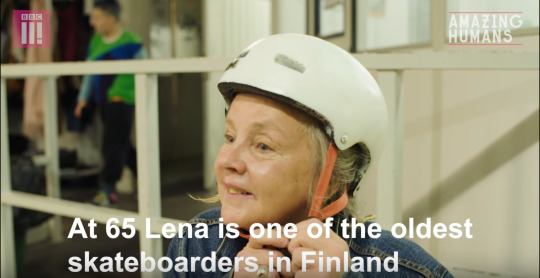
As a skateboarder, I carry a childish curiosity when I walk through the city always looking out for skateboarding opportunities. I intrinsically view the city in a subverted eye - an eye looking for continual play. I look at the infrastructure of roads and where they meet pavement, walls, banks stairs, squares and courtyards and I question them, assess their material quality, dimensions. And context. It has given me a visual language of the forms that make up the metropolitan space. The consequence being I have become more and more interested in architecture.
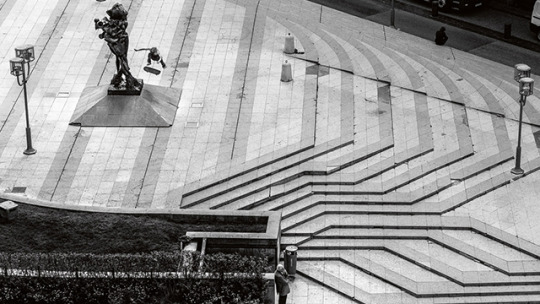
Lyon, Hotel De Ville Plaza

London, Southbank Undercroft
Skateboarding was originally a children’s fad, or an activity for slackers and bums. Now, unfortunately, it has become a career option where you can earn a lot of money through skateboarding competitions. More importantly for me it has become an art form and a way of living which still involves play.
As a skateboarder you are in conflict with the conventional uses of the city. Skateboarding is understandably noisy and fast, it dirties the surfaces and is just annoying to other people. Skateboarding is an active force on the ideas of inclusivity and exclusivity of the public and private area.
Similarities can be drawn with the reduction of roaming spaces for children and the conflict between privately owned spaces and the public and poses questions on who has the right to occupy an urban space and how it should be used. With aggressive interventions like skate-stoppers being added to ledges, handrails, stairs it is a visible attack against skateboarding.

Skate-stopper on ledge
Herzog and de Meuron
My favourite building in London is the Blavatnik Building by architects Herzog and de Meuron. The face turns on the base giving it a confusing cascading lift to the sky. The slices of windows that wrap around the building open up the floors for light. The sloping floor on each level guides you to walk up and through the building like a helter skelter. Within the whole of the Tate Herzog and de Meuron have made it spacious and open. They give you the possibility to move through the space how you will.

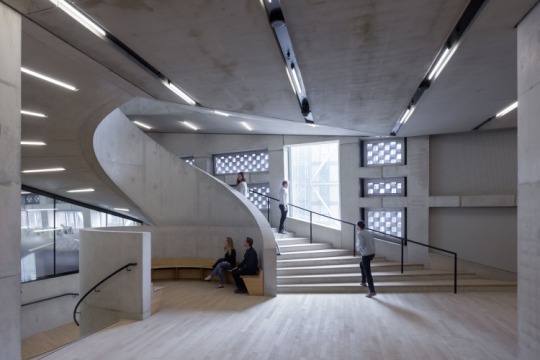


The slope in the Turbine Hall often showcases many different types of play. People rolling down, car races, running races and other such games enjoyed by all others.
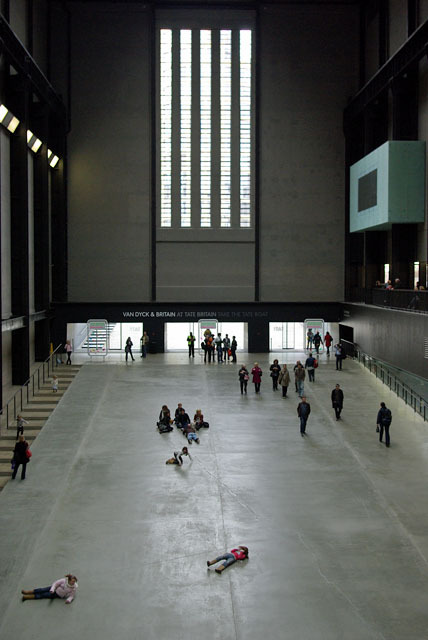
When I am in the Tate Modern I feel as if I can express myself freely in any way and really use the space to play. In the Tanks of Tate Modern, a friend and I found ourselves sliding across our bellies on the smooth polished concrete floor. This resulted in a lot of laughter.

The Tate Modern is a place to see art and not a place to work. However why can’t all buildings hold the potential to have possibility for play embedded in their architecture.
Another notable building by Herzog and De Meuron was their Toadstool Serpentine Pavilion that I visited when I was younger. I used the space to run around, climb and explore the different levels and crevices of the cork surface.



The 56 Leonard ‘Jenga Tower’ building in New York by Herzog and de Meuron is lifted straight out of childhood experiences. The building references the early skills children learn about structures through playing with wooden blocks. The building of structures teaches children about constructing structures. I partook in this type of object play often as a child and continue in 3D specialism. I believe object play has directly influenced my interests and my ambition to study architecture next year.


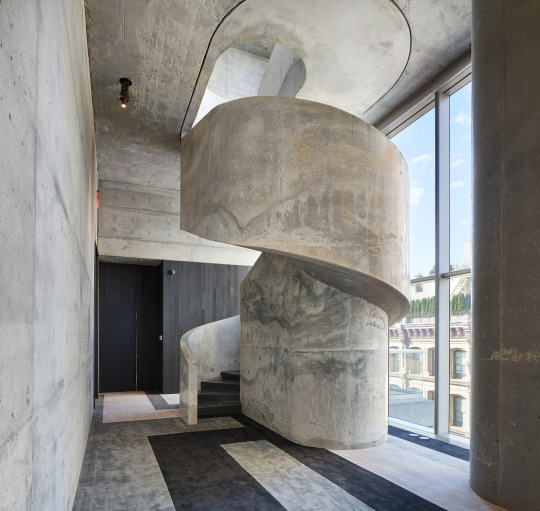
0 notes
Text
Trade and investment in the global economy
Digital Elixir
Trade and investment in the global economy
Foreign direct investment (FDI) is traditionally viewed as a key driver of prosperity in policy circles. According to the OECD (2002), “FDI is an integral part of an open and effective international economic system and a major catalyst to development. […] With most FDI flows originating from OECD countries, developed countries can contribute to advancing this agenda. They can facilitate developing countries’ access to international markets and technology.” In addition, modern FDI has become a vehicle for transferring intangible assets. According to the World Bank (2015), “[t]oday, FDI is not only about capital, but also – and more important – about technology and know-how, […] International patterns of production are leading to new forms of cross-border investment, in which foreign investors share their intangible assets such as know-how or brands in conjunction with local capital or tangible assets of domestic investors.” Academics share the hopes of policymakers for a positive economic impact of FDI, which plays central role in recent integration efforts. Slaughter (2013: 3) argues that “[i]f successfully negotiated, [TTIP and TPP] would deepen and strengthen ties with many of the most significant U.S. economic partners. A large majority of inward FDI in the United States already originates from TTIP and TPP countries, making these deals particularly important in the broader effort to recruit global business investment.”
Policymakers’ enthusiasm is based on the obvious partial equilibrium evidence of FDI impacts on sectoral output, employment, and capital returns. In contrast, there is relatively little structural evidence for the economy-wide importance of FDI as a vehicle for knowledge transfer and the effects on trade, domestic investment, and welfare. The lack of a unified multi-country framework of the global economy impact of FDI is, at least in part, because the relationship between FDI and various economic outcomes is intrinsically dynamic. However, as noted by Desmet and Rossi-Hansberg (2014), introducing dynamics to static multi-country trade models is hard, typically making “spatial dynamic models intractable, both analytically and numerically.” (p. 1212).
To gain traction with spatial dynamics in the case of FDI, in a recent paper (Anderson et al. 2019b) we build a framework that characterises the impact of FDI through interactions with trade and domestic investment in physical capital. On the trade side, the model is a member of the wide structural gravity class of new quantitative general equilibrium trade models described in detail by Arkolakis et al. (2012). Domestic investment in physical capital is modelled following Anderson et al. (2019a). The main novelty is the introduction of FDI on the supply side, where, in the spirit of McGrattan and Prescott (2009) and Markusen (2002), production uses FDI in the form of non-rival (or joint) technology capital along with labour and physical capital stocks. Thus, countries can use their technology capital in potentially all countries while using at home the technology capital from potentially all countries.
FDI liberalisation increases FDI, with general equilibrium implications for trade, income, and expenditure. An increase in bilateral FDI directly leads to higher income and to higher expenditure in the liberalising countries. Since higher expenditure leads to more accumulation of technology capital, FDI liberalisation between two countries will also trigger positive spillover effects on output and expenditure in third countries. Through its impact on output and expenditure, increases in FDI will also translate into increases in trade flows. The changes in FDI in our counterfactual experiment also indirectly affect trade between countries with no change in bilateral FDI. The structural gravity class of models describes equilibrium trade as if each country trades with a world market facing an average friction called multilateral resistance – one on outward shipments (export) and another on inward shipments (imports). Changes in outputs and expenditures change the equilibrium multilateral resistances because they are general equilibrium indexes, i.e. they capture the effects of changes between any two countries on consumer and on producer prices in any other country in the model.
Motivated by one of the opening quotes, which depicts FDI as a key driver of development, we quantify the importance of the novel FDI channel with a counterfactual experiment that describes a hypothetical world without outward and inward FDI from and to low- and lower-middle-income countries. The calibration is based on a balanced data set for 89 countries, which account for more than 96% of world GDP and for more than 94% of FDI in 2011. Of the 89 countries, 21 are classified as low- or lower-middle-income countries according to The World Bank’s Country and Lending Groups classification.
The impact from the elimination of FDI in the low- and lower-middle-income countries on trade and welfare in the world is depicted in Figures 1 and 2. Figure 1 reports the effects on trade, measured by the percentage change in total exports. Three main findings stand out. First, FDI is indeed an important driver of trade. On average, the gains from FDI in the poorer countries in the world amount to 7% of world’s trade in 2011, the year of our counterfactual analysis. Second, all countries lose from the counterfactual elimination of FDI in the poorer countries. Third, the impact is heterogeneous. Poorer countries lose the most, but the impact varies widely even within this group – some lose over 50% and some very little. The impact on countries in the rest of the world is significant as well. Some countries lose a lot (e.g. Luxembourg, Singapore, and Ireland) while others (such as India, Ecuador, and Dominican Republic) lose less. Pakistan and Sri Lanka actually see an increase in their total exports due to the elimination of FDI.
Figure 1 Percentage change in total exports from eliminating outward and inward FDI to and from low- and lower-middle-income countries
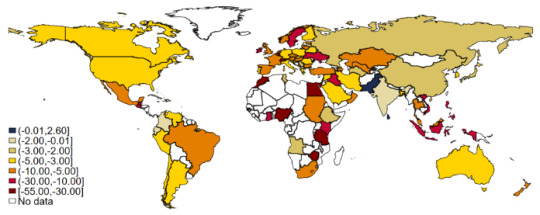
Figure 2 reports impact of the elimination of FDI in the poorer countries on welfare, measured by properly discounted consumption. Overall, in terms of direction, the welfare indexes in Figure 2 are consistent with the trade indexes that we present in Figure 1. On average, the gains from FDI amount to 6% of world’s welfare in 2011. Further, all countries in the world have benefited from FDI, but the effects are very heterogeneous. The directly affected low- and lower-middle-income countries see welfare changes up to over 50% (Morocco and Nigeria), while some of the remaining 68 countries, such as Ecuador, Turkmenistan, and Dominican Republic are hardly affected. A higher country-specific production share of FDI leads to larger welfare losses, all else equal. Intuitively, a larger importance of FDI in production leads to larger welfare losses when restricting FDI. A larger net log FDI position leads to larger welfare losses. Intuitively, if a country has more inward than outward FDI, restricting FDI will lead to larger welfare losses, as FDI is complementary to other production factors and therefore overall income increases more than FDI payments.
The results suggest that FDI has acted to reduce cross-country income inequality. In particular, the results suggest that FDI has led to significant increases in the welfare of some of the poorer economies in the EU. Given the renewed interest in the determinants of inequality (European Commission 2010), our results have potentially important implications for regional policy.
Figure 2 Welfare effects of eliminating outward and inward FDI to and from low- and lower-middle-income countries (%)

Overall, the analysis reveals that FDI is indeed an important component of the modern world economic system. The results suggest positive payoffs to policies designed to facilitate FDI, particularly those concerning protection of intellectual property. In addition, our structural approach opens new opportunities for further empirical and policy research. For example, the model delivers a structural FDI gravity system that resembles the traditional gravity system of the trade literature and lends itself to estimation with the most recent econometric techniques from the gravity literature. Another structural implication of the model is on the relationship between FDI and income/growth, which can be tested in the spirit of Frankel and Romer (1999). Yet another structurally motivated relationship that can be tested is the one between FDI and domestic investment.
References
Anderson, J E, M Larch, and Y V Yotov (2019a), “Growth and Trade with Frictions: A Structural Estimation Framework”, Economic Journal, forthcoming.
Anderson, J E, M Larch, and Y V Yotov (2019b), “Trade and Investment in the Global Economy: A Multi-country Dynamic Analysis”, working paper.
Arkolakis, C, A Costinot, and A Rodríguez-Clare (2012), “New Trade Models, Same Old Gains?,” American Economic Review 102(1): 94–130.
Desmet, K and E Rossi-Hansberg (2014), “Spatial Development”, American Economic Review 104(4): 1211–1243.
European Commission (2010), Investing in Europe’s Future.
Frankel, J A and D H Romer (1999), “Does Trade Cause Growth?”, American Economic Review 89(3): 379–399.
Markusen, J R and K E Maskus (2002), “Discriminating Among Alternative Theories of the Multinational Enterprise,” Review of International Economics 10(4): 694–707.
McGrattan, E R and E C Prescott (2009), “Openness, Technology Capital, and Development,” Journal of Economic Theory 144(6): 2454–2476.
OECD (2002), Foreign Direct Investment for Development: Maximising Benefits, Minimising Costs.
Slaughter, M J (2013), Attracting Foreign Direct Investment through an Ambitious Trade Agenda, Organization for International Investment Research Report.
Qiang, C, R Echandi and J Krajcovicova (2015), “Foreign Direct Investment and Development: Insights from Literature and Ideas for Research”, World Bank Private Sector Development Blog, 24 November.
Trade and investment in the global economy
from WordPress https://ift.tt/319IJsl
via IFTTT
0 notes
Text
Dimitrios Chartonas et al., Personality disorder: still the patients psychiatrists dislike?, 41 BJPsych Bull 12 (2017)
Abstract
Aims and method
In 1988, Lewis and Appleby demonstrated that psychiatrists hold negative attitudes towards patients with personality disorder. We assessed the attitudes of psychiatry trainees towards patients with borderline personality disorder and depression, expecting an improvement. 166 trainees were block randomised to receive one of four case vignettes that varied by diagnosis and ethnic group. We used Lewis and Appleby's original questionnaire and the Attitudes to Personality Disorder Questionnaire (APDQ).
Results
We received 76 responses. Lewis and Appleby's questionnaire showed more negative attitudes towards personality disorder than depression, with no significant patient ethnic group effects, and the APDQ also showed a (weak) trend towards more negative attitudes to personality disorder. In subgroup analysis, only in the White British patient group were there significantly more negative attitudes to personality disorder. Factor analysis showed significantly less sense of purpose when working with personality disorder.
Clinical implications
The perceived greater lack of purpose in working with personality disorder should be the target of clinical training and intervention. Targeted interventions that include training in managing personality disorder, supervision and practice in non-specialist, general psychiatry settings are important.
Personality disorder is characterised by an enduring dysfunctional and distressing pattern of inner experiences, behaviours and interpersonal interactions.1 Almost a quarter (24%) of people seen in primary care2 and 50% of people in secondary mental health services meet the criteria for a diagnosis of personality disorder.3 Patients with personality disorder have high rates of comorbidity4 and service utilisation.5 A meta-analysis, which identified 391 relevant publications and finally included 14, showed significant differences in prevalence between Black and White groups (although no differences between Asian or Hispanic groups compared with White groups), raising the question of whether there is a neglect of diagnosis in some ethnic groups.6
Although there is good evidence that borderline personality disorder (BPD) is a helpful diagnostic construct,7 some studies contest the validity (but not the clinical utility) of the diagnosis.8 Potter1 stresses that the psychological and interpersonal dynamics that patients with BPD bring to the clinical setting cause frustration and consternation among clinicians, such that BPD is now a diagnosis that can carry pejorative connotations and compound the stigma that such patients already face. Many patients with BPD feel rejected and disbelieved by clinicians.9 Improving clinicians' attitudes toward patients with BPD could bring them clinical benefit.10
Against this background, there have been systematic efforts to study clinicians' attitudes to personality disorder. A systematic review of the literature shows that healthcare professionals in general have negative attitudes towards such patients.11,12 A large study7 demonstrated that the clinician's occupational subgroup was significantly related to the attitude they adopted towards patients with BPD: staff nurses had the poorest self-ratings on overall caring attitudes, whereas social workers had the most caring attitudes. Social workers and psychiatrists self-rated highly on treatment optimism, whereas staff nurses rated poorly on empathy and treatment optimism. Overall, the authors suggested that education about the nature and treatment of BPD can lead to more positive attitudes, but also that clinicians with greater levels of experience in terms of both number of BPD patients and years of practice were more likely to express positive attitudes towards such patients. Bodner et al13 demonstrated that psychologists were less likely than psychiatrists and nurses to express antagonistic judgements towards patients with BPD and suicidal tendencies, whereas nurses were less likely to show empathy than psychiatrists and psychologists. They identified a number of factors influencing attitudes, including motivation to improve diagnostic skills, seniority, training and supervision, gender and familiarity with treatment modalities.
In 1997, Bowers et al14 developed a new instrument called the Attitude to Personality Disorder Questionnaire (APDQ). The APDQ is a reliable and valid measure of attitude to personality disorder, and is useful for outcome studies. It was tested among nurses and prison officers.15–17 One of these studies16 revealed that psychiatric nurses' attitudes were more negative than those of prison officers. Prison officers more often liked and showed an interest in prisoners with personality disorder, and they showed less fear and helplessness, less anger, more optimism about treatment and less frustration. The other studies found that nurses considered people with personality disorder difficult to treat; they were pessimistic about the efficacy and outcome of treatment and felt they were poorly trained to care for such patients.
Over 20 years ago Lewis & Appleby18 demonstrated that psychiatrists hold negative attitudes towards patients with a diagnosis of personality disorder, and that the diagnostic label was more influential on their attitudes than the patient's gender or class. Patients given a previous diagnosis of personality disorder were seen as more difficult and less deserving of care than controls. The authors concluded that a diagnosis of personality disorder carries enduring negative sentiments and is not used to guide effective treatment. For example, people with this diagnosis may experience difficulties when seeking help for psychiatric symptoms such as depression. The authors proposed that the concept of personality disorder be abandoned.
In 2002 the National Personality Disorder Development Programme was introduced in the UK, accompanied by the publication of No Longer a Diagnosis of Exclusion19 and Breaking the Cycle of Rejection,20 policy attempts that aimed to improve the evidence base of effective interventions for patients with personality disorder in specialist personality disorder services and, it was hoped, would also mitigate stigma.
Given the above, it seemed timely to see whether the attitudes of psychiatrists towards BPD showed any change. We selected psychiatric trainees, despite the difference in seniority/experience compared with Lewis & Appleby's original study (mean 16.5 years of psychiatric practice), as they are on the front line of service provision and are the next generation of consultant psychiatrists. Considering the findings of McGilloway et al6 and the multi-ethnic patient population in east and north-east London our sample was drawn from, we also examined the impact of ethnicity on attitudes.
Objectives
The objectives of the study were:
to assess the attitudes of psychiatry trainees towards patients with BPD compared with depression
to assess the impact of patient ethnicity on the attitudes of trainees to BPD.
Method
The study population consisted of the cohort of doctors training in psychiatry on the north-east London rotations (East London NHS Foundation Trust and North East London NHS Foundation Trust) between February and July 2013: core trainees 1–3, specialist trainees 4–6, general practice vocational trainees and foundation year 2 doctors. Overall, 166 doctors in training were block randomised in blocks of 8 to receive one of four different case vignettes (Box 1) that varied by previous diagnosis (BPD or depression) and ethnic group (White British or Bangladeshi). The case vignettes were modified versions of those used by Lewis & Appleby.18
Box 1: Case vignettes used in the study
Case 1
A 25-year-old White British woman is seen in out-patients. She complains of feeling depressed and crying all the time. She is worried she may be having a ‘breakdown’ and is requesting admission. She says she has thought of killing herself by taking an overdose of tablets at home. She has a history of an overdose 2 years ago after a relationship break-up, following which she saw a psychiatrist who diagnosed her with depressive episode. She recently lost her job and is worried about how she will pay the bills. She is finding it difficult to sleep and her GP prescribed nitrazepam, which she says has been helpful and which she would like to continue.
Case 2
Same as case 1, but the patient is Bangladeshi.
Case 3
Same as case 1, but the previous diagnosis is borderline personality disorder.
Case 4
Same as case 3, but the patient is Bangladeshi.
We used the following tools to measure attitudes:
Lewis & Appleby's 22 semantic differentials on a 6-point scale. Using the original scoring conventions, the semantic differentials were scored so that a higher score represented responses that were more rejecting or that indicated lack of active treatment.
APDQ: a questionnaire that consists of 37 affective statements about patients with personality disorder (e.g. ‘I like personality disorder people’, ‘I feel drained by personality disorder people’, ‘I feel patient when caring for personality disorder people’). Respondents rate the frequency of their experiences of these feelings on a 6-point Likert scale: never, seldom, occasionally, often, very often and always. The responses can be summed to give a total score; the higher the score, the more positive the attitude towards patients with a personality disorder. Five subfactors can be scored:
factor 1, enjoyment: warmth, liking for and interest in contact with patients with personality disorder
factor 2, security: the lack of fears, anxieties and helplessness in relation to patients with personality disorder
factor 3, acceptance: the absence of anger towards patients with personality disorder and a sense of being different from them
factor 4, purpose: feelings of meaning and purpose in working with patients with personality disorder
factor 5, enthusiasm: energy and absence of tiredness.
For the purposes of this study we modified the affective statements to ‘I like these patients’, ‘I feel drained by these patients’ etc. to correspond to the case vignette of either personality disorder or depression.
Analysis
As regards Lewis & Appleby's 22-item semantic differentials, we compared mean and s.d. scores on items. We assessed the structure of the items by running a principal components analysis. We summed scores of the most dominant factors that explained most of the variance and compared them by diagnosis and by ethnic group.
The APDQ scores (mean, s.d.) were compared for trainees across the four case vignettes. These were compared as groups that differed by diagnosis or by ethnic group in logistic regression analyses, to assess the role of diagnosis and ethnic group. We used the original APDQ factors as an additional variable to assess differences by patient ethnic group and diagnosis.
The study was granted ethical approval by the South West London REC 3 (ref. 10/H0803/159). We obtained the names and positions of all trainees in the rotation from the core training scheme manager for the north-east London rotations. We contacted all trainees via email asking them to complete questionnaires online (on the SurveyMonkey platform, www.surveymonkey.co.uk). All respondents gave informed consent and all responses were anonymous.
Results
We received 76 responses (response rate 46%). However, a small number of respondents failed to answer a number of questions. We thus analysed data from 73 responses to Lewis & Appleby's questionnaire (n = 19 for case 1, case 3 and case 4, and n = 16 for case 2) and 68 responses to the APDQ (17 for case 1, 15 for case 2, 20 for case 3, and 16 for case 4). Respondent characteristics are given in Table 1.
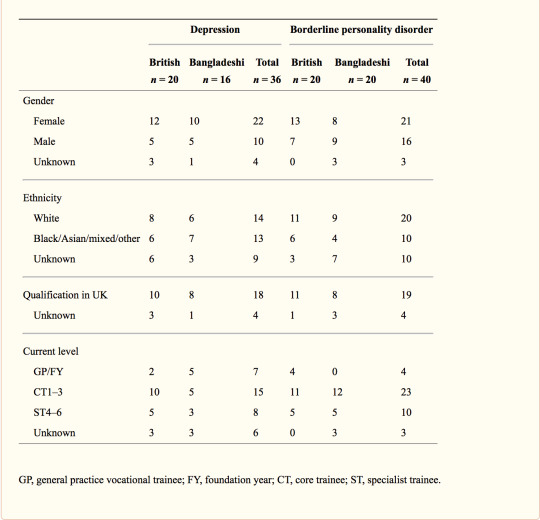
Table 1. Respondent characteristics
Lewis & Appleby's 22-item semantic differentials
The scale was subject to principal components factor analysis followed by an orthogonal rotation to identify 16 of the 22 items loaded (loading of greater than 0.5) on the first factor (eigenvalue 10.42, explaining 71% of the variance), with two further candidate factors (eigenvalue 1.68, explaining 11.5% and eigenvalue 1.00, explaining 6.1%, respectively) (Table 2). Only items from the first factor were summed to compare attitudes, as the second and third factors were accounted for by 3 items each and did not show a clear conceptual distinction between each other. The mean and s.d. score of factor 1 was compared by diagnosis and by ethnic group (case 1: mean 42.42, s.d. = 8.54; case 2: mean 48, s.d. = 8.71; case 3: mean 53.68, s.d. = 11.99; case 4: mean 51.53, s.d. = 10.51). The scores did not vary by ethnic groups. The rank sums showed significant differences by diagnosis, with higher scores (more stigma) towards personality disorder than depression (overall Kruskal–Wallis χ2 = 11.38, d.f. = 3, P = 0.01) (Table 3).
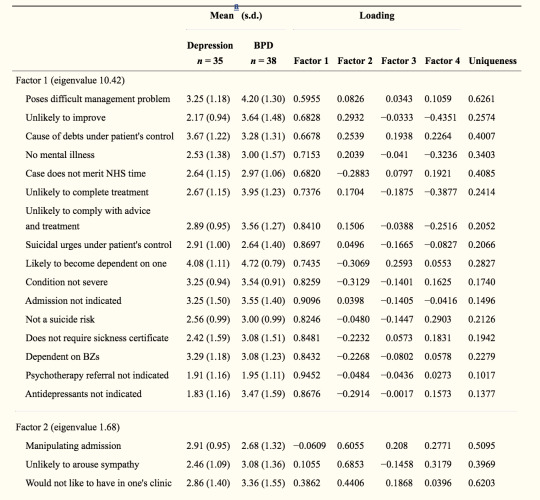

Table 2. Principal components analysis
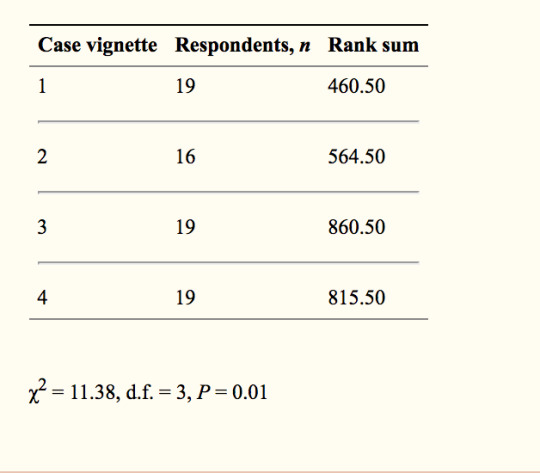
Table 3. Attitudes to BPD based on the four test vignettes (factor 1: Kruskal–Wallis equality-of-populations rank test)
APDQ
Multiple regression analysis of overall scores showed a weak trend towards lower scores in assessment of attitudes towards patients with a previous diagnosis of BPD compared with patients with a previous diagnosis of depression (lower scores indicate more negative attitudes in the APDQ and this is consistent with findings from the Appleby measure); however, this difference fell just short of statistical significance (z = 1.75, P = 0.08). There was no significant ethnic difference in attitudes towards patients. In subgroup analysis, only among White British patients with a previous diagnosis of BPD was there a lower overall score compared with White British patients with a previous diagnosis of depression (z = 1.98, P = 0.047).
This outcome had already been subjected to factor analysis by the original inventors of the measure. When we assessed scores on the basis of the five factors (using Kruskal–Wallis equality-of-populations rank) there was no statistically significant difference in scores for factors 1 (enjoyment), 2 (security), 3 (acceptance) and 5 (enthusiasm). However, there was a statistically significant (P = 0.03) difference found for factor 4 (purpose), with higher scores in attitudes (more positive) towards patients with depression (mean 4.60) compared with patients with a previous diagnosis of BPD (mean 4.15).
Discussion
Since the original study of Lewis and Appleby nearly 30 years ago, a number of studies spanning from 1993 to 2012, as summarised in the introduction, have consistently shown that clinicians hold negative attitudes towards personality disorder. Our finding of more negative attitudes towards personality disorder compared with depression among psychiatric trainees, using the same instrument as Lewis and Appleby, is in line with previous research. However, it is difficult to show and theorise a sense of longitudinal change. This is mainly because different studies have looked at different professional groups, including nurses, prison officers, social workers, psychologists and psychiatrists, with varying training and levels of experience, and in different countries and/or care settings. In addition, our study examined the attitudes of a less experienced sample of psychiatrists than the Lewis and Appleby study, and this has to be taken into consideration when comparing current attitudes with previous ones. However, the ongoing finding of more stigma towards patients with personality disorder, almost 14 years after the introduction of the National Personality Disorder Development Programme, is disheartening.
More encouraging is the lack of evidence of differences in attitudes to patients with personality disorder of different ethnicity. The greater negative attitudes to personality disorder than depression in White British but not in Bangladeshi patients raises questions of differences in how clinicians may view the disorder in different ethnic groups, especially given that culture influences significantly what is considered to be a person and personality. Culture influences a number of factors relevant to the construct of personality disorder, such as learning inside and outside the family, the threshold when personality vulnerability cannot be compensated for by the person, and the social threshold when such decompensations are labelled pathological.21–23 If one accepts personality pathology as universal,24 perhaps this finding can also raise further questions regarding under-diagnosis of personality problems in certain ethnic groups, although supporting such a link is beyond the scope of this paper and further research is needed looking into both the universality of personality disorder and issues of under-diagnosis or misdiagnosis.
The question of why psychiatrists stigmatise personality disorder is complex and not simple to answer. In addition to the issues discussed above in relation to caring for these often emotionally draining patients, it is of relevance that specific features of BPD can cause negative attitudes. It is known that a wide range of impulsive and potentially self-damaging behaviours are observed, especially early in the course of the disorder.25,26 These include gambling, irresponsible money handling, reckless driving and unsafe sexual practices,27 as well as problematic substance use, self-harm, suicidal behaviour and disordered eating.28–31 Most of these behaviours carry strong moral connotations, sometimes challenging social norms, and can thus provoke negative reactions, triggering clinicians' implicit beliefs and possibly prejudices towards such behaviours.
While mounting anti-stigma campaigns may be required, the finding of a greater lack of purpose in clinicians in working with personality disorder allows for more modest and targeted intervention. Lack of purpose and therapeutic pessimism raise the importance of designing targeted interventions which may include training in personality disorder. As personality disorder is prevalent in all psychiatric settings, this is an important part of training for all psychiatrists.
Limitations
Limitations of the present study include the small sample numbers, which, despite a reasonable response rate for a questionnaire study, makes it difficult to rely on comparisons between the groups, and thus compromises the power of the study. Our study population is taken from only two mental health trusts in the UK. However, the trusts cover both inner and outer London areas, and the training programmes are similar to those of others in the UK, as there is a specific framework for postgraduate training in psychiatry.
Recommendations
Increased training in evidence-based practice for generalist mental health professionals in borderline personality disorder may address the issue of clinicians' lack of sense of purpose. The emphasis is thus on increasing the skills of clinicians in managing personality disorder in general psychiatric settings, which usually lack the structure, training and resources to deal with these complex patients. The difficulties faced by general psychiatry clinicians have been acknowledged in the literature, and in that respect ‘structured clinical management’ has been discussed as an effective way of working with BPD patients in non-specialist settings, as long as certain principles are followed and interventions implemented.32
It has been shown that people with personality disorder present specific challenges to the therapeutic alliance.33–35 Training and supervision36–39 as well as participation in a Balint group40 can improve negative attitudes.
Patients with personality disorder can provoke strong countertransference reactions, there is thus an ongoing need for clinicians to monitor their countertransference when working with such patients. This highlights the ongoing need for psychotherapy training. Evidence-based psychotherapy treatments have a documented applicability as a useful model for general psychiatrists.41 Supervision and further training is also necessary for consultants, as they often supervise trainee doctors and inevitably influence them through their own attitudes to these patients.
Recent research on stigma reduction has identified certain key ingredients that anti-stigma initiatives should take into consideration: a recovery emphasis and having multiple forms of social contact are especially important for maximising outcomes.42 These key ingredients can be taken up to introduce specific initiatives to reduce stigma against personality disorder. For example, Knaak et al43 found that a 3-hour workshop on BPD and dialectical behavioural therapy (DBT) was successful at improving attitudes and behavioural intentions towards persons with BPD. This is in line with those studies that show that training and education programmes tend to improve attitudes.
References
1. Potter N. Mapping the Edges and the In-Between: A Critical Analysis of Borderline Personality Disorder. International Perspectives in Philosophy and Psychiatry. Oxford University Press, 2013. [Google Scholar]
2. Moran P, Jenkins R, Tylee A, Blizard R, Mann A. The prevalence of personality disorder among UK primary care attenders. Act Psychiatr Scand 2000; 102: 52–7. [PubMed] [Google Scholar]
3. De Girolama G, Reich JH. Personality Disorders (Epidemiology of Mental Disorders and Psychosocial Problems). World Health Organization, 1993. [Google Scholar]
4. Zanarini MC, Frankenburg FR, Dubo ED, Sickel AE, Trikha A, Levin A, et al. Axis I comorbidity of borderline personality disorder. Am J Psychiatry 1998; 155: 1733–9. [PubMed] [Google Scholar]
5. Bender DS, Dolan RT, Skodol AE, Sanislow CA, Dyck IR, McGlashan TH, et al. Treatment utilization by patients with personality disorders. Am J Psychiatry 2001; 158: 295–302. [PubMed] [Google Scholar]
6. McGilloway A, Hall RE, Lee T, Bhui KS. A systematic review of personality disorder, race and ethnicity: prevalence, aetiology and treatment. BMC Psychiatry 2010; 10: 33. [PMC free article] [PubMed] [Google Scholar]
7. Black DW, Pfohl B, Blum N, McCormick B, Allen J, North CS, et al. Attitudes toward borderline personality disorder: a survey of 706 mental health clinicians. CNS Spectr 2011; 16: 67–74. [PubMed] [Google Scholar]
8. Paris J. The diagnosis of borderline personality disorder: problematic but better than the alternatives. Ann Clin Psychiatry 2005; 17: 41–6. [PubMed] [Google Scholar]
9. Bilderbeck AC, Saunders KE, Price J, Goodwin GM. Psychiatric assessment of mood instability: qualitative study of patient experience. Br J Psychiatry 2014; 204: 234–9. [PubMed] [Google Scholar]
10. Dudas RB. What is it like to be diagnosed with bipolar illness, borderline personality disorder or another diagnosis with mood instability? Br J Psychiatry 2014; 204: 178–9. [PubMed] [Google Scholar]
11. Newton-Howes G, Weaver T, Tyrer P. Attitudes of staff towards patients with personality disorder in community mental health teams. Aust NZ J Psychiatry 2008; 42: 572–7. [PubMed] [Google Scholar]
12. McGrath B, Dowling M. Exploring registered psychiatric nurses' responses towards service users with a diagnosis of borderline personality disorder. Nurs Res Pract 2012; 2012: 601918. [PMC free article] [PubMed] [Google Scholar]
13. Bodner E, Cohen-Fridel S, Iancu I. Staff attitudes toward patients with borderline personality disorder. Compr Psychiatry 2011; 52: 548–55. [PubMed] [Google Scholar]
14. Bowers L, McFarlane L, Kiyimba F, Clark N, Alexander J. Factors Underlying and Maintaining Nurses' Attitudes to Patients with Severe Personality Disorder. Final report to National Forensic Mental Health R&D. City University London, 2000. [Google Scholar]
15. Bowers L. Dangerous and Severe Personality Disorder: Response and Role of the Psychiatric Team. Routledge, 2002. [Google Scholar]
16. Carr-Walker P, Bowers L, Callaghan P, Nijman H, Paton J. Attitudes towards personality disorders: comparison between prison officers and psychiatric nurses. Legal Crim Psychology 2004; 9: 265–77. [Google Scholar]
17. Bowers L, Carr-Walker P, Allan T, Callaghan P, Nijman H, Paton J. Attitude to personality disorder among prison officers working in a dangerous and severe personality disorder unit. Int J Law Psychiatry 2006; 29: 333–42. [PubMed] [Google Scholar]
18. Lewis G, Appleby L. Personality disorder: the patients psychiatrists dislike. Br J Psychiatry 1988; 153: 44–9. [PubMed] [Google Scholar]
19. Department of Health Personality Disorder – No Longer a Diagnosis of Exclusion. Policy Implementation Guidance for the Development of Services for People with Personality Disorder. Department of Health, 2003. [Google Scholar]
20. National Institute for Mental Health in England Breaking the Cycle of Rejection: The Personality Disorder Capabilities Framework. NIMHE, 2003. [Google Scholar]
21. Neki JS. Some problems of nosology and classification. In Personality Development and Personal Illness (eds Neki JS, Prabhu CG, editors. ): pp. 117–27. All India Institute of Medical Sciences, 1970. [Google Scholar]
22. Paris J. Social factors in the personality disorders. Transcult Psychiatry 1997; 34: 421–52. [Google Scholar]
23. Sharan P. An overview of Indian research in personality disorders. Indian J Psychiatry 2010; 52 (suppl. 1): S250–4. [PMC free article] [PubMed] [Google Scholar]
24. Oldham JM. Personality disorders: current perspectives. JAMA. 1994; 272: 1770–6. [PubMed] [Google Scholar]
25. Stepp SD, Pilkonis P. Age- related differences in individual DSM criteria for borderline personality disorder. J Pers Disord 2008; 22: 427–32. [PMC free article] [PubMed] [Google Scholar]
26. Stevenson J, Meares R, Comerford A. Diminished impulsivity in older patients with borderline personality disorder. Am J Psychiatry 2003; 160: 165–6. [PubMed] [Google Scholar]
27. American Psychiatric Association Diagnostic and Statistical Manual of Mental Disorders, Text Revision (4th edn). APA, 2000. [Google Scholar]
28. Dougherty DM, Mathias CW, Marsh DM, Papageorgiou TD, Swann AC, Moeller FG. Laboratory measured behavioural impulsivity relates to suicide attempt history. Suicide Life Threat Behav 2004; 34: 374–85. [PubMed] [Google Scholar]
29. Rosval L, Steiger H, Bruce K, Israel M, Richardson J, Aubut M. Impulsivity in women with eating disorders: problem of response inhibition, planning or attention? Int J Eat Disord 2006; 39: 590–3. [PubMed] [Google Scholar]
30. Soloff PH, Lynch KG, Kelly TM, Malone KM, Mann JJ. Characteristics of suicide attempts of patients with major depressive episode and borderline personality disorder: a comparative study. Am J Psychiatry 2000; 157: 601–8. [PubMed] [Google Scholar]
31. Trull TJ, Sher KJ, Minks-Brown C, Durbin J, Burr R. Borderline personality disorder and substance use disorders: a review and integration. Clin Psychol Rev 2000; 20: 235–53. [PubMed] [Google Scholar]
32. Bateman AW, Krawitz R. Borderline Personality Disorder: An Evidence-Based Guide for Generalist Mental Health Professionals. Oxford University Press, 2013. [Google Scholar]
33. Nehls N. Brief hospital treatment plans for persons with borderline personality disorder: perspectives of inpatient psychiatric nurses and community mental health center clinicians. Arch Psychiatr Nurs 1994; 8: 303–11. [PubMed] [Google Scholar]
34. Fraser K, Gallop R. Nurses' confirming/disconfirming responses to patients diagnosed with borderline personality disorder. Arch Psychiatr Nurs 1993; 7: 336–41. [PubMed] [Google Scholar]
35. Cleary M, Stiegfried N, Walter G. Experience, knowledge and attitudes of mental health staff regarding clients with a borderline personality disorder. Int J Mental Health Nurs 2002; 11: 186–91. [PubMed] [Google Scholar]
36. Krawitz R. Borderline personality disorder: attitudinal change following training. Aust NZ J Psychiatry, 2004; 38: 554–9. [PubMed] [Google Scholar]
37. Treloar AJ. Effectiveness of education programs in changing clinicians' attitudes toward treating borderline personality disorder. Psychiatr Serv 2009; 60: 1128–31. [PubMed] [Google Scholar]
38. Commons TAJ, Lewis AJ. Professional attitudes towards deliberate self-harm in patients with borderline personality disorder. Aust NZ J Psychiatry 2008; 42: 578–84. [PubMed] [Google Scholar]
39. Shanks C, Pfohl B, Blum N, Black DW. Can negative attitudes toward patients with borderline personality disorder be changed? The effect of attending a STEPPS workshop. J Pers Disord 2011; 25: 806–12. [PubMed] [Google Scholar]
40. Airagnes G, Consoli SM, De Morlhon O, Galliot AM, Lemogne C, Jaury P. Appropriate training based on Balint groups can improve the empathic abilities of medical students: a preliminary study. J Psychosom Res 2014; 76: 426–9. [PubMed] [Google Scholar]
41. Zerbo E, Cohen S, Bielska W, Caligor E. Transference-focused psychotherapy in the general psychiatry residency: a useful and applicable model for residents in acute clinical settings. Psychodyn Psychiatry 2013; 41: 163–81. [PubMed] [Google Scholar]
42. Knaak SK, Modgill G, Patten SB. Key ingredients of anti-stigma programs for health care providers: a data synthesis of evaluative studies. Can J Psychiatry 2014; 59 (suppl. 1): S19–26. [PMC free article] [PubMed] [Google Scholar]
43. Knaak S, Szeto ACH, Fitch K, Modgill G, Patten S. Stigma towards borderline personality disorder: effectiveness and generalizability of an anti-stigma program for healthcare providers using a pre-post randomized design. Borderline Personal Disord Emot Dysregul 2015; 2: 9. [PMC free article] [PubMed] [Google Scholar]
0 notes
Text
“I said what I said, and it was wrong, or it was taken wrong, and now it's all this...”
BASICALLY.
So the furor, such as it is, that has resulted from a fairly innocuous post of mine seems to have taken on a bit of a life of its own, so I feel somewhat responsible and need to address certain things. A lot of what's been said seems frankly disconnected from anything I actually wrote, so I'm going to cover some but not all of the misconceptions – particular themes have been chosen because honestly some of the ideas I've been credited with are quite hurtful, to me personally and I think to a few other people. I'm not 'at'-ing people because I'm not sure it would be at all fruitful or worthwhile to do so, and I'm not going to rebut things line-by-line because that seems more counterproductive than anything. My goal here is to hopefully dampen 'the controversy' (again, such as it is!) rather than inflame it.
On the one hand, I stand by the bulk of what I said – there's been some serious misinterpretations going around, some of which are genuinely baffling – but I can also see that my tone and my contextualization could have been improved. I do 'read' a little bratty or something in that post, which is something I should try to improve upon in the future. As for this post, I'm trying to essentially be the opposite of how I sounded there – be, like, very straightfoward and emotionally open and hopefully not stick my foot in it, or whatever. I'm basically a pathologically shy and conflict averse person, and totally just hoped that this would blow over, so all of this is way beyond my comfort zone. I hope people will see that this post is very much heartfelt, and imbue their reading of it with some generosity towards me and my intentions.
Anyways, the bulk of it, in which I pick out those misinterpretations that I would find it particularly upsetting to let stand as somehow representative of how I think:
a) Re John and being a fan: I love John. I can seriously count on one hand the number of people I love and admire more than John, and the subset under consideration for that isn't, like, 'famous people I like' or 'musicians', it's 'everybody who has ever existed.' I quite simply adore John and if I didn't I wouldn't expend the effort I do into trying to understand him. The implication that I can't possibly be a Beatles 'fan' (said in quotes, no less! Super disheartening), let alone a longtime fan is quite bizarre and insulting. I mean, I think there's a base presumption of 'grace' we should try to extend to other fans: none of us think any of them were or are irredeemable; we are all here because we love them; we all want to see them clearly and fairly. I am (clearly!) not some troll shouting 'John sux!' or whatever. It's not a mark of love for me or anyone to refuse to see John as he was – and by this I don't mean that not seeing John exactly as I do is a failure of anyone else, or deliberate, or that my interpretation is accurate, or whatever, just that FOR ME to limit my interpretation in order to 'keep' John sufficiently lovable or whatever would be silly. John was/is plenty lovable! I don't need to 'protect' myself from whatever dark places may have existed in his mind because I am entirely capable (as I think we all are) of loving him through that (not in spite of that, but THROUGH it, with empathy for him). I don't have to love or accept everything about John to love him – I don't have to love Yoko, or heroin, or Allen Klein, or stupid anti-Semitic cracks, or whatever (which is not to compare those things straightforwardly – obviously – but to make the point that it's okay to dislike things John liked!). We don't owe it to him as fans to make excuses for him; what we owe him is the same as what we owe any human being, which is just to try to understand where he's coming from. That's all that I was trying to do in my post – just delineate the thought processes he may have been having. I don't think I need to surround every discussion about John with 5 dozen caveats about his mental health issues or drug use simply because I have assumed that we all know these things and accept them as the (only) basis for further conversation (and actually I did reference both of those as clear sources of his behavior – I don't know that I can much more explicitly reference his suffering mental health than to say he was experiencing a break with reality). Furthermore, the idea that John's behavior during the final years of the Beatles was at least in part based on virulent paranoia directed at Paul as well as a desire to punish him is not something I came up with – it's a somewhat standard interpretation at this point. Even Paul (who also manages to love John while acknowledging his faults!) has admitted that John became very paranoid, jealous, neurotic, etc. Michael Gerber from Hey Dullblog once commented something like, to paraphrase, the hardest thing to accept as Beatles fans is that John broke up the Beatles and he did it willfully and deliberately...I don't know that that's THE hardest, but it's certainly up there. It's incredibly emotionally draining to consider the dynamics at work during the break-up, but I also think it's worthwhile to do so as honestly as we can, because we love them all so much and because they have so much to teach us, even when it's through this painful, agonizing shit.
b) Re things assumed about me or what-have-you: It strikes me as really quite unfair to assume that because I've never discussed certain things on this blog (or in that specific post), that I don't understand or have never experienced them and am coming at them from a position of somewhat cruel disengagement or w/e. The title of the blog isn't 'Bisexuality, Mental Illness, Drug Addiction & Me', so I really didn't consider it under the purview and have generally refrained from inserting too much of 'myself' (or at least myself non-filtered through Beatles). I don't talk about feminism, or cats, or Mad Men or make-up or agile software development or robotic vacuums because despite my interest in all of them, that's not the intention of my tumblr. Nevertheless, some grotesque oversharing in hopes of re-assembling/salvaging some of what's been misconstrued:
- I am bisexual...too...like many people are. This gets back to the whole 'text doesn't always telegraph meaning particularly well', but the paragraph for which I was criticized for sounding like a Nat Geo narrator or w/e...as I was writing it I was actually getting quite emotional thinking of...John, like, maybe discovering his sexuality at 16, because that was the exact age where I was literally writing in my diary in cryptic little coded comments about being attracted to girls, and then blacking the comments out and tearing them out of the journal and ripping them up because I was SO fucking ashamed and scared and alone with all of it. Basically, I am not at all looking at this from the perspective of an outsider, let alone a heteronormative outsider.
- To be accused or w/e of not understanding or being unsympathetic to mental illness is more than a little ironically funny to me, because literally the reason I started this blog, writing fics, etc is because after over a decade on anti-depressants, I went off them about six months ago (lest this too be misconstrued, I am not advocating this (or un-advocating it), it simply is). My brain has therefore been 'allowed' to loop incessantly/unconstrainedly on the Beatles for the first time since I was fifteen – so mental illness is quite literally why I'm here! Funny stuff. I don't want or need or feel obliged to go into much more detail about this, so let it suffice to say that I have deep understanding and sympathy for mentally ill people, for John in particular, and I fully appreciate the impact of mental illness on a person's behavior, and any flippancy is, ah, semi-literally gallows humor.
- If I sound hardened or unsympathetic with regard to drug addictions...it's partially because I am on some level. I invite anyone who takes issue with this to go re-live their childhood with the trauma of multi-generational drug and alcohol abuse that I lived with, because I will guess that anyone who is less than saintly, as we all are, will end up just as jaded about it as I am, just from the inescapable daily grind of taking care of addicts. Sorry to sound fairly bitchy about this point, but...idk, man, it's always really really difficult to have people be like, “have you considered their feelings? Have you devoted enough of your life to ritually gutting yourself on the pyre of this or that person's addiction?” Like, yes? Sorry, all the mornings where I had to make sure my dad hadn't choked to death on his vomit before I got on the school bus have kind of drained my sympathy. Nonetheless, some of my favorite people are junkies...
c) Re Linda and Paul: I would never disrespect their relationship, and this is far and away the most upsetting thing to have people skew, because I admire what they were able to create and sustain SO much – it means so much to me in terms of what is possible even from the blackest fucking depths. Linda could have been another Francie, or Heather Mills, or Yoko, and GOSH, how much fucking poorer the world would have been, how much darker. Linda and his kids gave Paul something to live for, a whole second life after the center fell out of his first. They were actually able to make a happy life that was snatched from total chaos and despair – that's so incredible and awe-worthy to me. When I said that Paul chose Linda over dying, I was not putting down their relationship, or devaluing it or her (I think she is maybe the most admirable person in all of Beatle-dom), or anything even remotely like that. For me, there is no deeper compliment to give someone than to say that they chose to keep going when they could've died. I mean, compliment is not even the word for it, I honestly don't think I have the capacity to express this..but, like, this is soul-deep for me, the deepest, sincerest possible feeling. I derive enormous comfort and strength on literally a daily basis from the choice Paul made in the winter of 1970. Believe me when I say I would never denigrate Paul's experience or Linda's role in it or the love and commitment they showed each other.
d) Re interpretation versus facts: There's some criticism based on me presenting my ideas as facts. I don't think I did this – I couched the thing repeatedly with 'conjecture' (in all caps!), 'my interpretation', 'I think', 'maybe' and 'may', 'a range of possibilities', 'possibly', 'presumably', 'might', etc. I was not presenting what I said as verifiable fact but as my evolving understanding of what may have happened. Besides...all of us are here because we think there was or could have been a romantic/sexual component to John & Paul's relationship. This is not something that is at all verifiable (and it even very often requires that we assume people are lying!). Practically everything we say is conjecture based on our very unorthodox interpretation of sometimes conflicting/contradictory/bewildering information, and I am no more (or less) guilty of presenting my ideas as fact than, I think, anyone here.
e) Re Yoko: I get the sense that this was the main initial point of disagreement in all of this, and the rest of it was kind of...throwing stuff and seeing what stuck (unfortunately some of it seems to have). This is actually the only intractable issue – it's not one based on misunderstanding or a failure on my part to be clear enough. I dislike Yoko exactly as much (or more!) as I conveyed in the original post, and I have good reason for it. Pretty much every day of my life I learn something about her or about the world, relationships, responsibility, children, how a person should treat others, etc, that makes her behavior that much more noxious, inexcusable, and reproachable. Once upon a time I was thirteen and believed wholeheartedly in the Ballad of John & Yoko narrative – but as an adult, I simply can't countenance it. If we were not talking about 'John and Yoko' but rather about 'Joe and Sally Schmoe', or my brother and his girlfriend, or the next case on the docket in the local family court, there would be no question that this was a profoundly unhealthy and damaging relationship. Like...are most love affairs as enormously, relentlessly destructive as theirs was? Is there anyone from John's pre-1968 life that was allowed to really remain a part of his life post-Yoko? What kind of healthy romantic relationship cuts a person off from everything else? Is 'all that I know is just what you tell me' anything other than a deeply disturbing sentiment? Some of this can be laid at John's feet but on the other hand his 25 year old secretary (as well as every other significant person in his life except for his parents and probably Mimi) was able to coax him into being a BETTER person, whereas he only seemed to become an unhealthier and more damaged person the longer he spent with Yoko (and the feminism thing...like, the most feminist thing he could have done would be sending Cynthia an additional $10,000 a month – 'look at the one you're with' or were with, after all). I can't say that Yoko didn't love John but I will say that she didn't love him well – based on the standards for human relationships and interaction that we are willing to apply to normal people. To quote John Dunbar (who is definitely a longtime John fan!), “If I had set out to destroy John Lennon, I could not have done any better than to introduce him to Yoko Ono.”
If anyone wants to talk any more about this, please message or ask me (I will likely not respond to asks in the interest of not encouraging divisiveness or whatever, but I do appreciate what I’ve been sent). I can't control what anyone posts, obviously, and there are maybe still sensitive and insightful things to be said about some of it, so go ahead if you feel the need. For my part I probably won't engage any further publicly, especially since it's been unhelpfully dug into the ground (over...and over...and over) and there's a certain amount of like...willful misconstruing that's going on that’s just not worth getting into.
And just because it came on shuffle, and because sometimes Paul is exactly what one needs him to be, I'll end by saying:
“Is it better to love than to give in to hate?
Yeah, we'd better take good care of each other,
Avoid slipping back, off the straight and narrow”
:)
#nerves man nerves#if i disappear for a while or longer#don't worry or whatever idk#i am just#easily stressed and over-sensitive#yikes at all of this just yikes#going to go throw up now lol
22 notes
·
View notes
Text
FMP Research Blog
I want to question the modern nature of consumerism through art, in particular the ever-advancing technological aspects, considering the many impacts it has on my personal experience as well as the potential larger implications for society. ‘Consumerism’ covers such a vast territory of ideas and subjects, having had a particularly convoluted relationship with art throughout the past century, and I want to narrow down and expand on the specific areas that matter to me. I am interested in researching artists and their key works on the subject, seeing new exhibitions and reading around the culture of consumerism historically and today.
The high-speed race of product and infrastructural innovation is what I believe fuels the constant re-invention of the art occupying this space. This a crucial starting point and an area that I want to research thoroughly in this blog, going back to the roots of consumerism in the realm of art. I want to understand the intrinsic links between the work made and the cultural/social/political environment that fostered it, importantly focusing on how this is different from my perception in the present day.
What interests me is the new way we interface with the world, being able to receive a constant stream of information into our pockets, always having access to the internet and the internet almost always having access to us. I am attempting to gain some understanding of this cultural zeitgeist; the powerful presence of social media, virtual realities, targeted and tailored news and advertising. Researching these issues will inform a large area of my questioning.
I think there is potential in this subject area because of the reach it has into everyday life for such a large percentage of the population. Witnessing the changes within my lifetime, growing up with the rise of the internet, has influenced my choice of consumerism as a point of artistic exploration because I feel strongly compelled to confront the problems associated with it.
I began my research by looking at Walter Benjamin’s influential essay of cultural criticism, ‘The Work of Art in the Age of Mechanical Reproduction’, originally published in in Germany, 1935. The essay proposes the idea that the mass reproduction of art has a profound effect on the ‘aura’ of the art itself, a devaluation of any sort of ‘unique beauty’ or traditional concepts of creativity and the true craft involved. The artworks presence in time and space is lost through the means of reproduction and the artwork is stripped of its function as an individual unit. All output is filtered through the culture industry and created, in part, to function in the optimum interests of the economy.
These ideas are still relevant to the consumer climate of today, yet I think a key distinction is apparent in the potential scale of a reproduction today, where an image can have global reach in a matter of minutes. The concept of an artwork having to be mechanically reproduced is neutralized under the assumption that everyone already has a smartphone or internet access. This is a really exciting concept as the capacity for an artwork to reach an audience has broken new boundaries, an area I would like to explore in developing my work.
Questioning the value of the artwork in this image saturated environment is also an intriguing area, in the internet age the aura of an artwork that occupies that platform is so far removed that it becomes hard to distinguish where the artwork starts and finishes. This is another interesting realm to explore, once an artwork is ‘exhibited’ on the internet, who gets to decide who it belongs to anymore?
A cornerstone of Benjamin’s ideas is the concept of an artwork’s reproduction ‘substituting unique experience for mass existence’, whilst he sites this as a criticism, a positive is that it opens up the opportunity for mass audience participation. This has got me thinking about how I could incorporate elements of mass interaction, using a live stream of comments for example, within a video installation, allowing a piece to grow artificially with what others input. I am interested in the way you can become disillusioned with the online world, becoming too attached to an online persona and potentially losing touch between the virtual and real world. Using an artwork as a sort of platform to represent this really interests me because you could have a feed of responses from people on the internet who don’t know they are being exhibited in public, questioning where the boundaries of virtual reality land.
The ideas of the Pop Art movement (starting mid-1950’s) are hard not to reference when considering consumerism in art, with corporate symbols, mass-produced goods and common objects of our society being taken out of their traditional context and scrutinized for their symbolic value in the gallery. This was a major theme in Pop Art, incorporating aspects of mass culture into the work and blurring the boundaries between what is considered ‘high art’ and ‘low culture’.
These are broad themes that inform my work, yet the aspect that is particularly making me question how I make work involves considering what attitude towards consumer culture I want to convey in the work. Richard Hamilton’s ‘Just what is that makes today’s homes so different, so appealing?’ (1956) speaks to me of the mass banality and spiritual nakedness of consumer goods, depicting a hollow fantasy of a highly idealized home using images from an American magazine. The work is a critique in my mind, yet I can also see how it could be read as an ovation of sorts to the modern life, I love that the work is left open and ambiguous because I myself do not have a fully formed stance when considering the face of consumerism today. Having an element of confusion and debate within the piece is more interesting than a clear answer and I think it speaks to the wider context of a very divided social and political environment.
The culmination of a tight Brexit referendum in the UK and the 2016 US presidential election has for the moment highlighted a cultural rift in society, the prominence of a distinct right party opinion and left party opinion in the context of so many issues is so evident and a constant talking point in the news. Whilst my work is not overtly political, I think that this is always important to be considering. I think that it becomes a bit ‘safer’ to have your work pick a side because you know how your work will be received by those on that same side, I want to try and steer clear of doing this so that I don’t dilute my own ideas, especially due to the ties between consumer-based corporations and political parties.
I have looked at the research from the media analytics company ComScore to get a better idea of the contemporary issues in an online world. The average American spent approximately 2 hours and 51 minutes on their smartphone per day in 2017, over a lifetime, we are projected to spend around 5 years and 4 months on social media alone. They draw a comparison between smartphones and slot machines in the way both alter you brain chemistry to respond to intermittent rewards and short bursts of information (with low levels of focus required).
These online platforms are designed to hook you and are only going to become more seamlessly integrated into everyday life. A 2018 study by the University of Amsterdam proved a strong correlation between certain anxiety and depression symptoms increasing in young adults who check social media more frequently. This is sure to be a major cultural issue over the coming years and a signal of the more immoral aspects associated with the personalised forms consumerism can now take. I’m interested in the idea of trying to predict how the cultural landscape is going to shift, a potential route for the final project could involve exploring visions of the near future in video, using the medium itself to parody the way society gets entranced with television and the illusion of screens.
A pioneer of video art, I have looked at the work of Nam June Paik. His 1964 piece, ‘TV Cello’ was revolutionary in breaking down the barriers between art and technology, involving a performance from the avant-garde cellist Charlotte Moorman on a cello composed of 3 stacked TVs, showing footage of her playing amongst intercepted broadcast feeds. By taking the domestic television set out of its normal setting and using it in a subversive performance, Paik questions the increasingly dominant role television would play in shaping public opinion. The screens still play yet the only sound comes from the raw, electric cello notes. I am interested in building up a body of work that experiments with the configurations of sculpture and screen, I like how playfully Paik explores the medium and the relationship between mass media and American life. Paik’s work has developed over time into huge installations, such as the 1995 ‘Electronic Superhighway’ featuring 51 video installations over a neon map of the USA, each monitor representing the typical character of that area. It’s an explosion of information and I love the hypnotic quality of having so many distinct cultural references in the footage, it encourages the audience to pry and interact with the work, trying to take in each individual screen.
I visited the Goldsmiths CCA recently to see the first solo exhibition (in London) of the artist Kris Lemsalu, ‘4LIFE’. It is a body of works tracing the stages of life from “birth to death, and ‘the bit in the middle’”, expressed through sculptural installation. The hallucinogenic world she created was filled with fantastical multi-limbed creatures that populate the disturbing and evocative environment. It felt a very personal vision of the artists existential fears and I liked that aspect a lot. The totemic objects had a rich symbolism, cast-off items of clothing appeared as mangled shells of Lemsalu’s past. It made think of the installations as quite a dejected goodbye to the consumerist lifestyle. It reflected some of my own doubts about consumerism and has got me thinking about whether I should incorporate more elements from personal experience into my work. The direct emotion conveyed in Lemsalu’s work affected me in certain ways more so than some of the other works I've seen that depict consumerism in a more ‘clinical’ and plainly referential manner. I have realized the trap that can come with repeating the processes of consumerism back on itself in a work, a mass appropriation of imagery trying to match the intense flow of media can be a less effective communicator than a single, sentimental object.
Consumerism as a subject area is opening up a lot of new opportunities to expand my work. The vast concepts it covers are pushing me to expand into new mediums, such as video and sculptural installations. I have previously explored some specific areas of consumerism through paintings and collages, focusing on ideas of celebrity idolization and technological malfunctions, but I have not looked at the idea of consumerism as a ‘whole’ and as a cultural phenomenon in itself. The dualism of consumerism is that you can choose to explore it from the cold, corporate angle, as well as from a much more personal aspect and I am interested in seeing how this relationship will develop in my work.
0 notes
Text
Here’s The Real Reason The Fed Is Making Absurd Monetary Decisions
BY JOHN MAULDIN
I have often written about the Fed's abysmal track record in managing the economy. Here Lacy Hunt and Van Hoisington of Hoisington Investment Management explain the reasons for the Fed's consistently poor track record.
They start by considering the Fed’s “dual mandate,” which sets “the goals of maximum employment, stable prices and moderate long-term interest rates.” (And yes, that is actually three goals, not two.)
But a problem arises, the authors note, “because considerable time elapses between the implementation of the monetary actions designed to follow the mandate and when the impact of those actions take effect on broader business conditions.”
The time lag can easily be three years or longer, with the result that policy changes often end up being pro-rather than countercyclical. To make matters even worse, “the economic risks from adherence to this dual mandate are now much greater than historically due to the economy’s extreme over-indebtedness, poor demographics and a fragile global economy.”
But I’ll let Lacy Hunt and Van Hoisington unpack the idea themselves.
Hoisington Quarterly Review and Outlook, Second Quarter 2017
By Dr. Lacy Hunt and Van Hoisington
The Fed’s Dual Mandate
“Dual mandate” is one of the most commonly used phrases in U.S. central banking. The current Chair of the Federal Reserve often mentions it in both speeches and testimony to Congress. Not surprisingly, this is an extremely hot topic in monetary economics, and execution of this mandate has profound significance.
The mandate originated in The Federal Reserve Reform Act of 1977. This legislation identified “the goals of maximum employment, stable prices and moderate long-term interest rates.” Ironically, these goals have come to be known as the Fed’s “dual mandate”, even though there are actually three goals. The manner in which the Fed operates in following these goals has had and will have dramatic effects on economic activity. In this report we consider:
What is the causal link between the mandate and the Fed’s capacity to act in a counter-cyclical fashion?
How has the dual mandate morphed into the Phillips Curve?
What are the arguments for and against a Phillips Curve based approach for conducting monetary policy?
What does empirical research reveal?
In view of the extreme over-indebtedness and other adverse initial conditions, what are the immediate consequences of using a Phillips Curve based dual mandate for the economy, the Fed and fixed income investors?
Causality
To achieve the goals of this mandate (maximum employment, stable prices and moderate long-term rates), the Fed will inevitably tighten for too long and by too much. This occurs because considerable time elapses between the implementation of the monetary actions designed to follow the mandate and when the impact of those actions take effect on broader business conditions. By waiting to recognize a definitive change in inflation and unemployment, monetary policy changes will be pro-, not counter-cyclical. The time difference between leading or causative measures like the money and reserve aggregates, on the one hand, and the economically lagging series of the unemployment rate and inflation, on the other hand, can easily be three years or longer.
This difference between the actions of the Fed and the reactions within the economy explains why the Fed historically has not begun easing cycles until the economy was either in, or on the cusp of, a recession. When the Fed takes action, relief is painfully slow in arriving. Importantly, the economic risks from adherence to this dual mandate are now much greater than historically due to the economy’s extreme over-indebtedness, poor demographics and a fragile global economy.
To demonstrate, suppose that in the fourth quarter of this year, unemployment turns significantly higher while the inflation rate decelerates from its already subdued pace. The downturn that the Fed would be witnessing in the fourth quarter could be reflecting policy actions all the way back to the fourth quarter of 2015 when they initiated the current tightening cycle. This cumulative evidence is reflected in the monetary and credit aggregates (Charts 1 and 2). This change in economic fortunes might cause the Fed to accelerate the rate of growth in the monetary base and lower the policy rate in order to stimulate money and credit growth. However, the monetary and credit aggregates might not respond to these first steps until 2019 or even 2020, thus putting the Fed three years or more out of sync with the needs of the economy, suggesting a prolonged period of severe underperformance.
Being out of step with the goals of a counter-cyclical monetary policy will arise as long as the Fed keys its decision-making on unemployment and inflation, rather than on maintaining financial stability, which focuses on the reserve, monetary and credit aggregates. Achieving such stability, however, is now much more difficult for the Fed than in the past. Until the economy became so heavily indebted, M2 was a consistent leading economic variable. Now M2 only leads recessions. Until the debt overhang is corrected (which does not appear to be in the immediate future), the velocity of money is likely to continue declining. Thus, when the Fed eases in the future, the strong leading relationship between M2 and the economy will no longer prevail.
There have always been lags between the time of a policy shift and evidence of that shift in the broader economy. However, in a heavily indebted economy, with the velocity of money likely falling further, and policy rates close to the zero bound, the Fed’s current capabilities are decidedly asymmetric. Any easing actions taken now would be far less powerful than the steps taken in the prior tightening cycle. Thus, by keying off the dual mandate in an economy with a severe debt overhang, the Fed would be more disadvantaged than normal in trying to come to the quick aid of a faltering economy.
From the Dual Mandate to the Phillips Curve
The Federal Reserve Reform Act of 1977 does not spell out the nature of the trade-off between the unemployment rate and the inflation rate, nor does it say how the Fed should act if the mandates are at odds in terms of the policy approach.
The potential problems that arise from this lack of clarity are clearly illustrated by the current situation. The Fed has extended the current tightening cycle twice this year, with the latest move on June 14. At the time of the latest decision, headline and core CPI had year-to-date price increases of 1% and 1.3%, respectively, substantially below their 2% target. Additionally, the latest twelve-month increases in both of these inflation gauges were below the 2% target. Only the unemployment rate warranted more restraint. This means that inflation and unemployment are at odds, thus the dual mandate is dead. It now boils down to the Fed’s interpretation of the Phillips Curve.
The most definitive study of the Fed’s operations is widely considered to be the multi-volume series, A History of the Federal Reserve written by the late Carnegie Mellon economist Alan Meltzer (1928-2017). Volume I examines the span from the creation of the Fed in 1913 until the accord with the Treasury in 1951. Volume II, Book 1 covers the years from the accord in 1951 until 1969, while Volume II, Book 2 discusses the period from 1970 until the end of the great inflation period in the mid-1980s. In this scholarly historical examination, Meltzer, on the basis of price and financial stability, gave the Fed high marks in only one-fourth of its years of operation. Meltzer made many seminal contributions to economics, including identifying the algebraic determinants of the money multiplier and outlining the transmission of monetary policy actions to the real economy.
In his 2014 paper, “Recent Major Fed Errors and Better Alternatives,” Meltzer summarized the root cause of the Fed’s policy errors and long record of failed forecasts as follows: “The Fed’s error was to rely on less reliable models like the Phillips Curve ... that ignore or severely limit the role of money, credit, and relative prices.” By focusing on the Phillips Curve, Meltzer contends that the Federal Open Market Committee (FOMC) overemphasizes information in monthly and quarterly data periods while giving insufficient attention to persistent trends in money and credit, which are the very aggregates that the Fed supplies. To paraphrase Meltzer, by relying on the Phillips Curve, the FOMC avoids developing a strategic view of their role and the complex world in which they operate. As the massive credit buildup leading up to 2007 illustrates, the Phillips Curve mandate also diverts the Fed’s attention from important regulatory matters that can have extremely consequential and long lasting macro implications.
The key passage that Meltzer writes to describe the inadequacies of the Phillips Curve/ dual mandate within the Fed is as follows:
No less an authority than Paul Volcker explained publicly and to the staff that the Phillips Curve was unreliable and not useful. As Chair, he gave many talks about what I have called the anti-Phillips Curve. Volcker claimed repeatedly that the best way to reduce unemployment was to reduce expected inflation. He did not use Phillips Curve forecasts. He ran a very successful policy. Alan Greenspan was less outspoken, but he also rejected Phillips Curve forecasts as unreliable. Instead of finding a better model, the staff resumed use of Phillips Curve forecasts. They were again unreliable as should be evident from the repeated prediction errors ... Year after year, growth and employment are below forecast. One might hope that repeated forecast errors all in the same direction would raise doubts about the usefulness of the model or models and initiate search for a better model. This does not appear to have happened.
In the three years since this prophetic passage, the string of unbroken economic forecasts continued unabated.
The Phillips Curve
The Phillips Curve represents the relationship between the rate of wage inflation and the unemployment rate. In a 1958 study, New Zealand economist A. W. H. (Bill) Phillips (1914-1975) found an inverse relationship between wage inflation and the unemployment rate in the United Kingdom from 1861 to 1957. A high unemployment rate correlated with slowly increasing wages, while a lower unemployment rate correlated with rapidly rising wages.
According to Phillips, the reasoning for this finding was that the lower the unemployment rate, the tighter the labor market, thus firms would raise wages to attract scarce workers. Conversely, at higher rates of unemployment the pressure on wages abated. Thus, this curve attempts to capture a cyclical process that can be used for evaluating the business cycle. This curve presumes the average relationship between wage demands and the unemployment rate is stable, thus there is a rate of wage inflation that results if a particular level of unemployment persists over time. As time has passed, Phillips Curve proponents have also asserted that a stable relationship exists between the unemployment rate and the overall rate of inflation, not just that for wages. The original Phillips Curve shows a downward sloping line on a graph, with wage inflation on the vertical axis and the unemployment rate on the horizontal axis.
In a 1967 peer-reviewed paper, Edmund Phelps challenged the theoretical structure of the Philips Curve. Independently of Phelps, Milton Friedman (1912-2006) in his Presidential address to the American Economic Association in 1967 (published in 1968) came to similar conclusions. They reasoned that well-informed rational employers and workers would pay attention only to real wages (i.e. the inflation adjusted level of wages). In the view of Friedman and Phelps, real wages would adjust to make the supply of labor equal to the demand for labor, and the unemployment rate would then stand at a level uniquely associated with the real wage rate. In time this uniquely associated real wage rate has come to be called the “natural rate of unemployment.”
Friedman and Phelps argued that the government could not permanently trade higher inflation for lower unemployment. When the natural rate of unemployment prevails, the real wage is constant. Workers who expect a given rate of inflation insist that wages increase at the same rate to prevent the erosion of their purchasing power.
Consistent with Friedman and Phelps, consider the effects of a monetary policy designed to expand economic activity in an attempt to lower the unemployment rate below its natural rate. The resulting increase in demand (pricing power) encourages firms to raise prices faster than workers anticipate. With higher revenues, firms are willing to employ more workers at the old wage rates and in some cases are willing to somewhat boost them. With rising wages, workers willingly supply more labor, which leads to a drop in the unemployment rate. Initially, they do not realize that their purchasing power has eroded since prices have advanced more rapidly than expected. In this initial period workers suffer from what is known as a “money illusion” – the rise in nominal wages is not equal to the rise in real wages. As workers come to anticipate higher rates of price inflation over time, they see through the money illusion, and less labor is supplied and demanded. The real wage is restored to its old level, and the unemployment rate returns to its natural rate. Today, the opposite case is present. Monetary restraint is limiting demand and eroding pricing power, causing employers to restrain wages. Once workers realize this restraint is not a cut in real wages, they will continue to supply the same amount of labor. The Phillips Curve trade-off does not exist in either of the two alternative situations.
Phelps and Friedman also distinguish between these effects over the “short run” and the “long run”. Phillips Curves only prevail so long as the average rate of wage inflation remains fairly constant. Only in such a limited time frame will wage inflation and unemployment be significantly inversely related. Once the higher inflation is fully incorporated into expectations, unemployment returns to the natural rate, with the result that the natural rate of unemployment is compatible with any rate of inflation. These long and short run relationships can be combined in an “expectations augmented” Phillips Curve. The quicker workers adjust price expectations to changes in the actual rate of inflation, the quicker the unemployment rate will return to the natural rate and the less successful the government will be in reducing unemployment through monetary and fiscal policies. The expectations augmented Phillips Curve approach is used in and appears to play a major role in the Federal Reserve’s large-scale econometric model.
Empirical Evidence
We examined the relationship between percent changes in real average hourly earnings and the unemployment rate from 1965 through 2016 – the entire historical record for wages. This sample is comprised of over 600 monthly observations (Chart 3). The trendline fitted through the observations does have a slightly negative tilt, but the line is not statistically different from a straight horizontal line, which signifies a total lack of responsiveness of real wage changes to the unemployment rate. The adjusted R2 is 0.04, which is not statistically significant. Thus, our empirical findings are consistent with the causality outlined – that the Phillips Curve assumption is not valid. Cherry picking through the data points can identify limited time periods when a greater inverse relationship exists between wage increases and the unemployment rate. As many researchers have pointed out this was true of the 1960s. From the first half to the second half of the 1960s, nonfarm business sector compensation per hour (a widely followed measure of labor compensation) increased from 3.6% per annum to 5.9% as the unemployment rate fell from 5.7% to 3.8%. The critical point is that these individual episodes of an apparent Phillips Curve trade-off are too weak and too infrequent to establish an enduring relationship over time.
The adherents to the Phillips Curve do not accept these various empirical criticisms. For many decades, they insist that the poor results are due to the fact that the basic relationship has not been properly quantified. They point to the problems capturing leads and lags between the unemployment rate and wage changes as well as difficulties that arise from measuring expectations and working with aggregate data. For followers of the Phillips Curve, it is just a matter of time before these issues of statistical quantification are resolved.
These arguments are not compelling, yet they have been used repeatedly for at least a half a century. As the years have passed, the constantly restated Phillips Curve formulations have regularly missed major business cycle developments, a pattern which has been evident in the Fed’s record. The Fed presided over the worst U.S. peacetime inflation from 1977 to 1981, and tightened before all of the recessions after 1977. The Fed did contain the Panic of 2008 with excellent lender of last resort tools, but a far better result might have been achieved if the Fed had learned the lesson of the 1920s and prevented the massive buildup of debt prior to 2008 that the regulatory powers of the Fed were designed to prevent.
For most of the past eight years, the frequently restated Phillips Curve models have pointed to a sustained acceleration in wage and price inflation that has failed to materialize. These failures not only impair monetary policy but also portfolio decisions based on the presumed efficacy of the Phillips Curve and the reliability of the dual mandate. Based on the slowdown in the monetary and credit aggregates, and the continuing fall in the velocity of money, the rate of inflation is more likely to moderate rather than accelerate, even as the unemployment rate in May 2017 stood at a sixteen year low. Thus, inflation, on average, moved lower during this current expansion, contradicting the forecasts for higher inflation based on the Phillips Curve concept. the velocity of money, the rate of inflation is more likely to moderate rather than accelerate, even as the unemployment rate in May 2017 stood at a sixteen year low. Thus, inflation, on average, moved lower during this current expansion, contradicting the forecasts for higher inflation based on the Phillips Curve concept.
Implications
For the Fed, the more advisable approach would be to pull the Phillips Curve relationships from their model and their policy decisions. Instead, they should rely on capturing the strategic role of the monetary transmission mechanism and its potentiality for moving through the reserve, monetary and credit aggregates in a highly leveraged economy. If the Phillips Curve proponents are right, and the quantification efforts are eventually proved to be valid, then at that point they can be inserted into the Fed’s model as well as into their subjective decision-making process.
This is relevant to investors as well. If adherence to the dual mandate induces financial insatiability, then investor performance, like overall economic activity, will be directly influenced. If the Fed’s mandate consistently leads them in the wrong direction, then long-term investors may often be forced to construct portfolios that are contradictory to the error-prone words, forecasts and policy actions of the FOMC. Moreover, investors should expect that the Fed’s actions will create substantially more volatility in the financial markets and particularly so over the short-term. Operating with strategic views and multi-year trends, rather than trying to focus on the Fed-generated noise in many monthly and quarterly indicators, may be a preferred method of generating investor returns.
Our economic view for 2017 is unchanged and continues to suggest that long-term Treasury bond yields will work irregularly lower. The latest trends in the reserve, monetary and credit aggregates along with the velocity of money point to 2% nominal GDP growth for the full year, down from 3% in 2016. This would be the third consecutive year of decelerating nominal GDP growth and the lowest since the Great Recession. This suggests that the secular low in bond yields remains well in the future.
Van R. Hoisington
Lacy H. Hunt, Ph.D.
Get Varying Expert Opinions in One Publication with John Mauldin’s Outside the Box
Every week, celebrated economic commentator John Mauldin highlights a well-researched, controversial essay from a fellow economic expert. Whether you find them inspiring, upsetting, or outrageous… they’ll all make you think Outside the Box. Get the newsletter free in your inbox every Wednesday.
1 note
·
View note